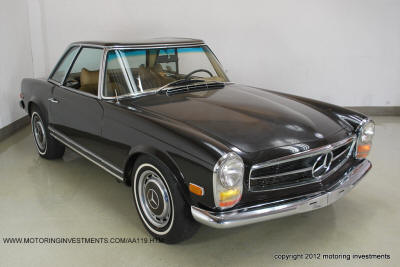 |
 |
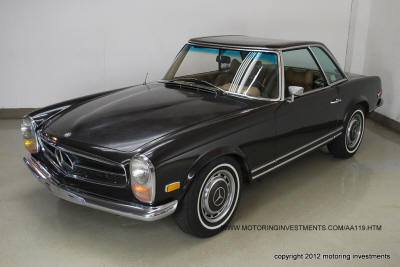 |
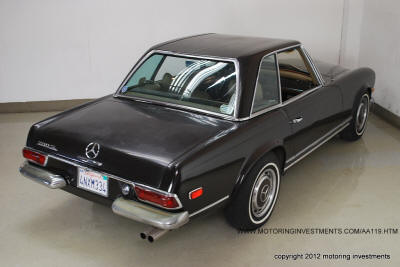 |
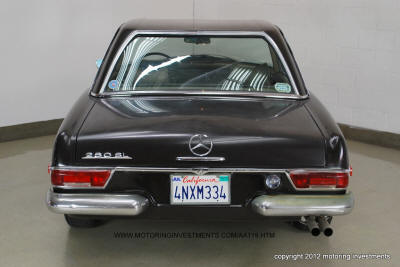 |
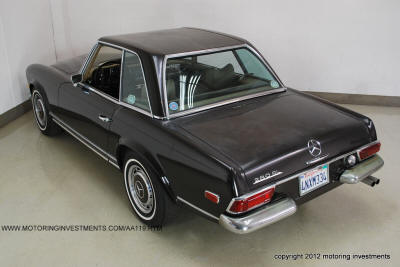 |
| |
|
|
 |
 |
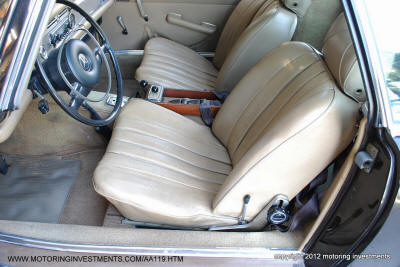 |
| |
|
|
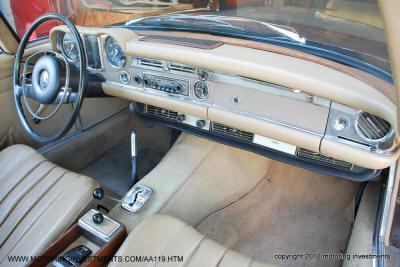 |
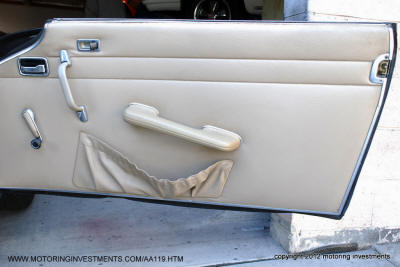 |
 |
| |
|
|
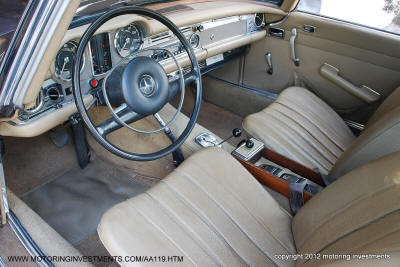 |
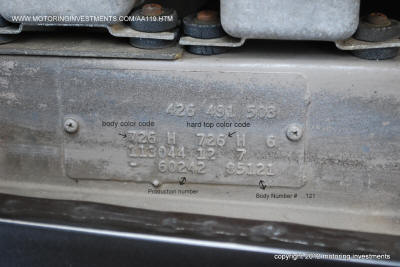 |
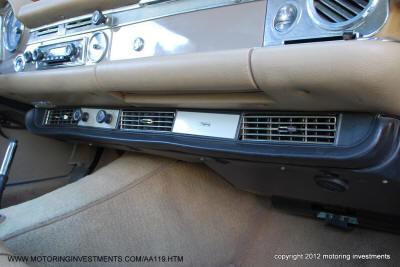 |
| Code 726
H equals Beige-Grey ( H stands for the paint supplier at the time,
Herberts) |
| |
|
|
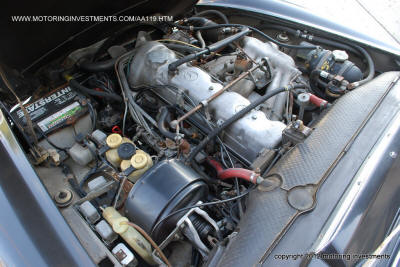 |
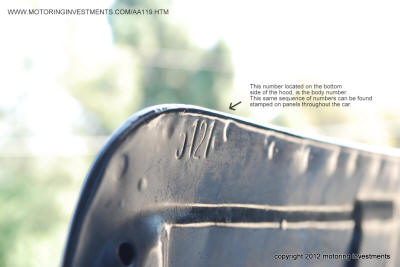 |
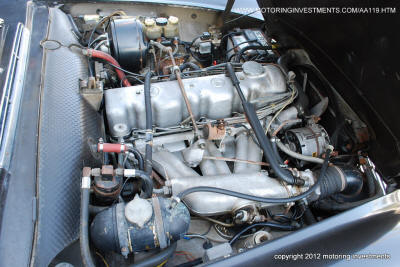 |
| |
All numbers
match. |
|
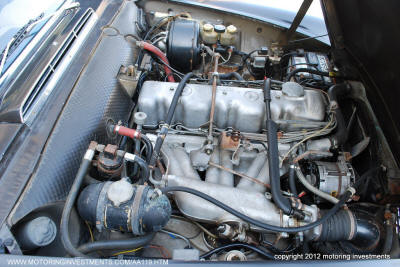 |
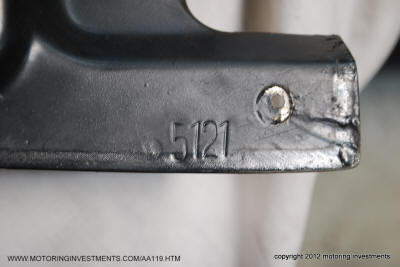 |
 |
| |
|
|
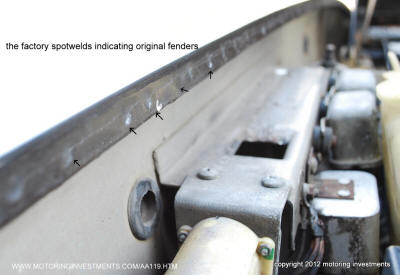 |
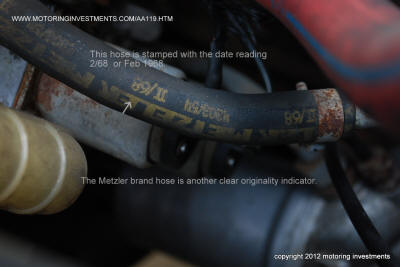 |
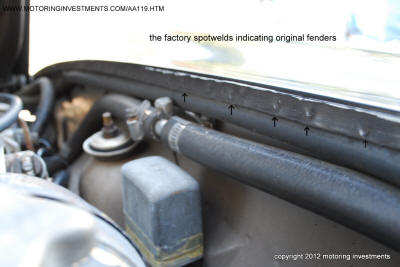 |
| |
|
|
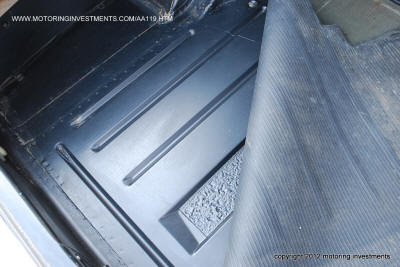 |
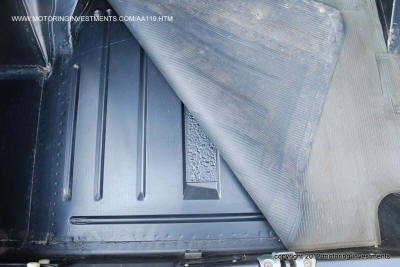 |
| Very unusual
virginal trunk floor. Typically even dry California cars have surface
rust here. |
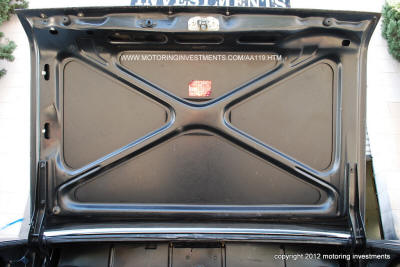 |
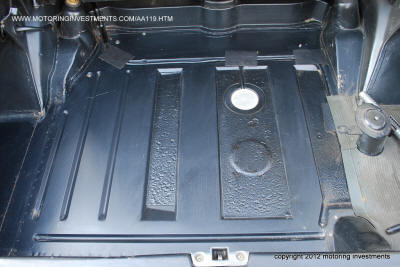 |
With our Motoring Investments inspection report now completed, we
begin the restoration. It is imperative to begin the
restoration process with the most solid example you can find. Below are
some photographs documenting
the
extensive restoration this car is undergoing.
|
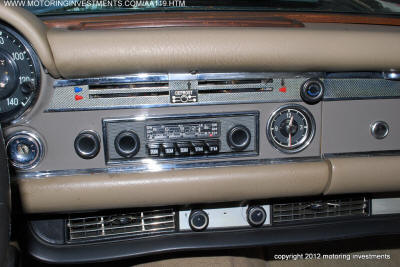 |
 |
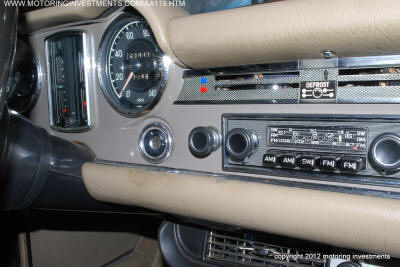 |
| |
|
|
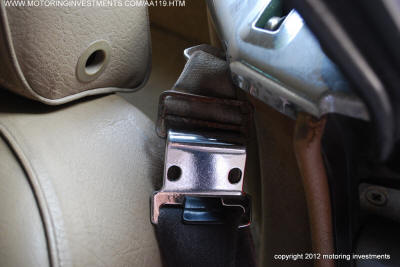 |
The picture
to the left is of the rare
and still present, seat belt hook.
The image to the right is of the
original color coordinated threshold sill
pad. Notice that it is beige. (M-B only
supplies new replacements in black).
We may have to be creative here. |
 |
| |
|
|
 |
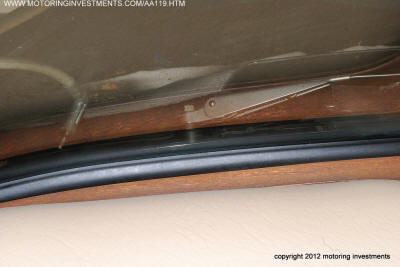 |
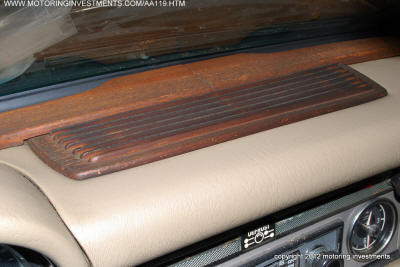 |
| |
|
|
 |
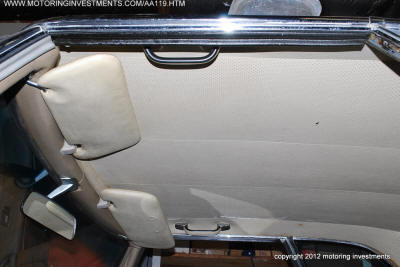 |
 |
| |
|
|
 |
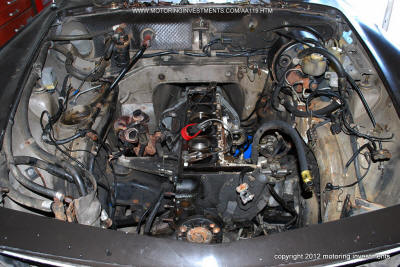 |
 |
| |
|
|
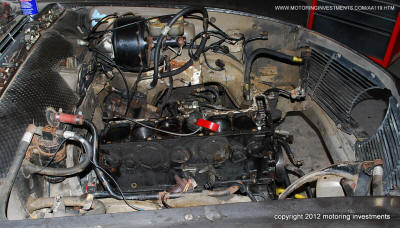 |
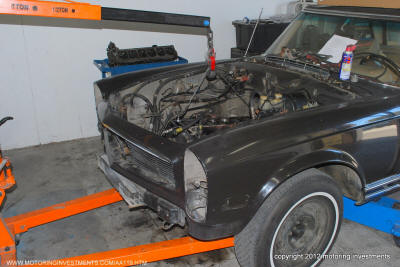 |
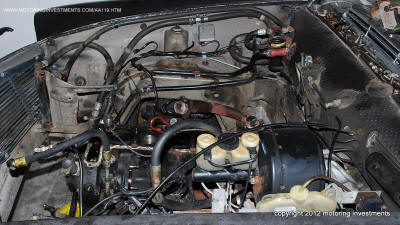 |
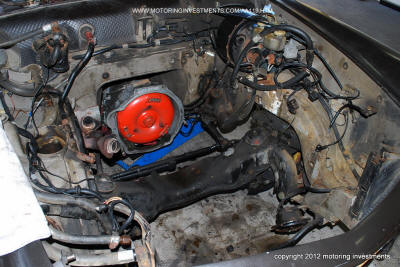 |
 |
 |
| |
|
|
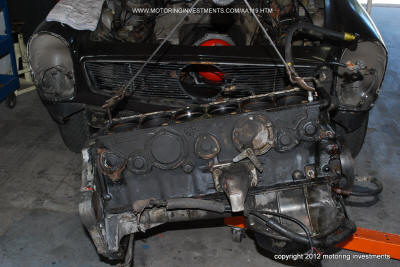 |
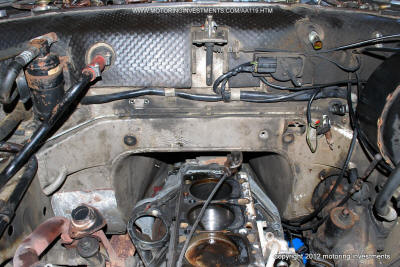 |
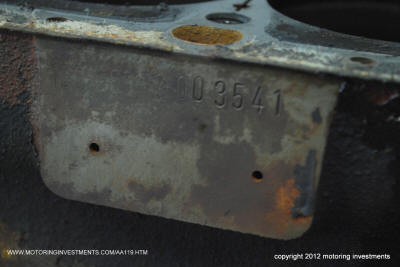 |
| |
|
|
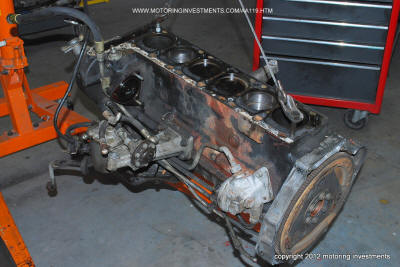 |
These photos
are of the engine stripped
down to the bare block. All parts
are removed, catalogued, inspected, and
replaced or reconditioned to look
and function as new. |
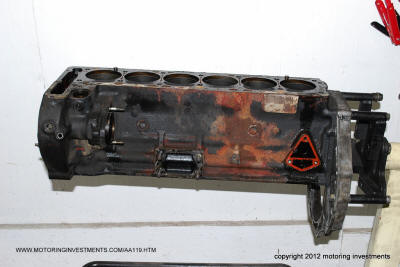 |
| |
|
|
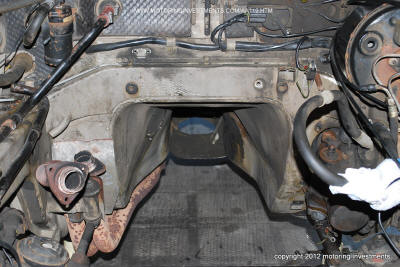 |
The photos to
the left and right are
of the transmission tunnel area with the
transmission out of the car. The
transmission will also undergo a
complete and detailed restoration,
both mechanical and cosmetic. |
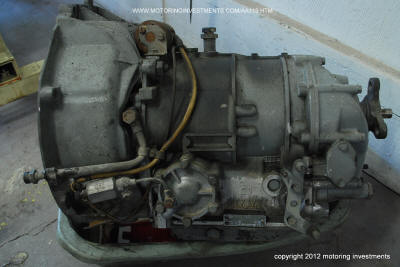 |
| |
|
|
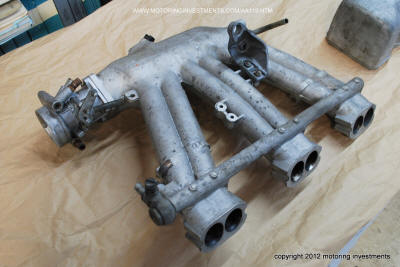 |
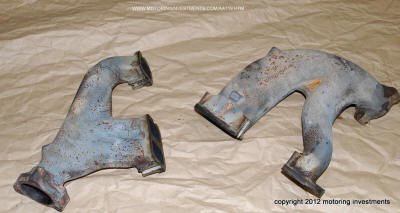 |
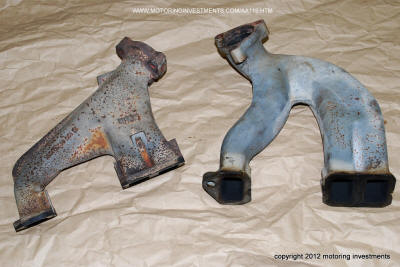 |
| |
The above picture shows the exhaust
manifolds
before being sent out for coating.
We have them coated in a high grade aerospace
ceramic finish. This process lowers the
temperature in the engine bay and extends the life of neighboring
components.
|
|
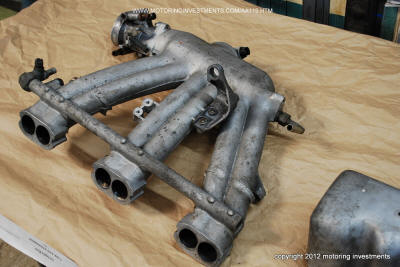 |
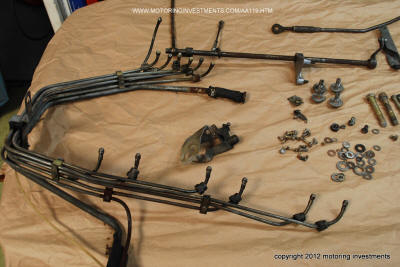 |
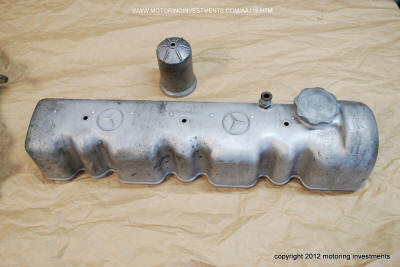 |
| |
|
|
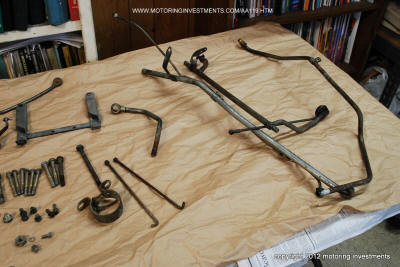 |
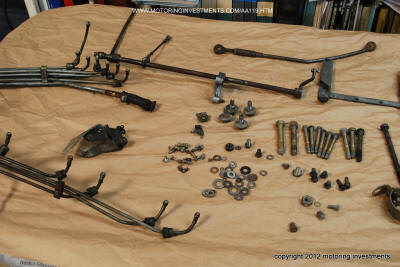 |
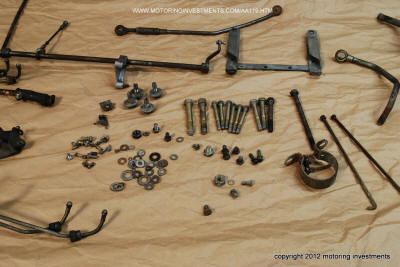 |
| |
|
|
 |
The images
above are
of all the hardware, fuel lines, and fasteners
being sent out to undergo a
cleaning and re-plating process. |
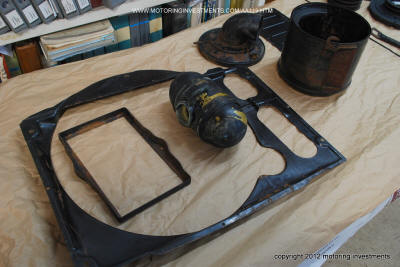 |
| |
|
|
 |
 |
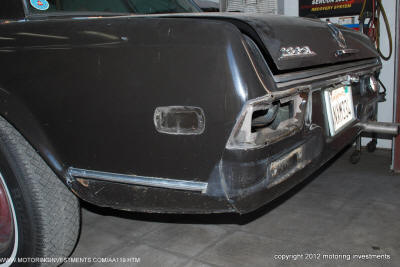 |
| |
|
|
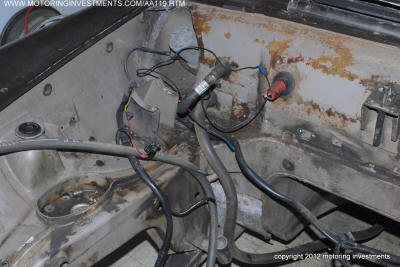 |
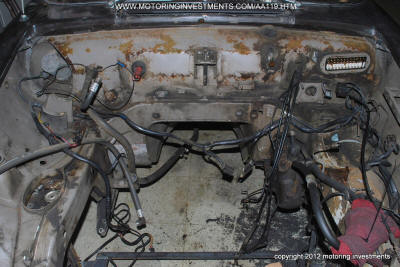 |
 |
| |
|
|
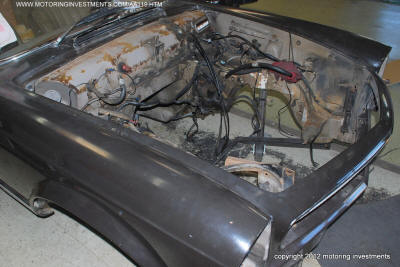 |
 |
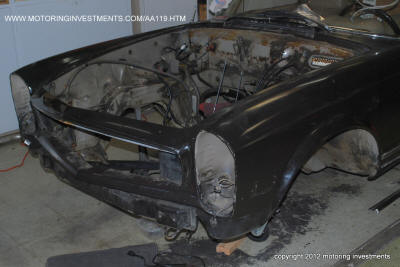 |
| |
|
|
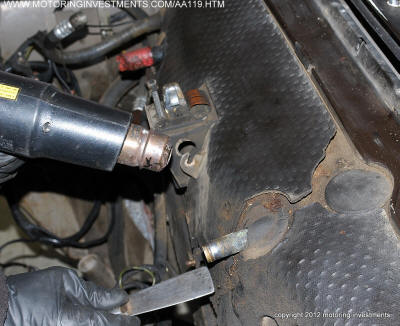 |
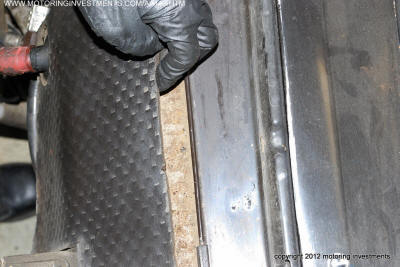 |
 |
| |
|
|
 |
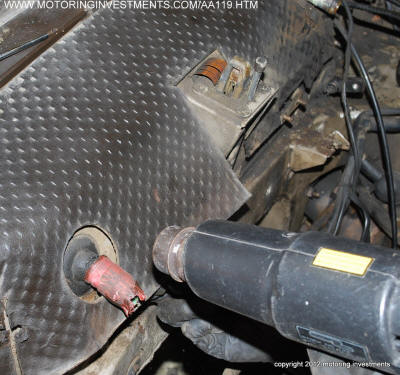 |
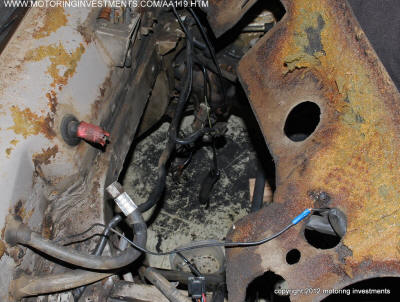 |
| |
|
|
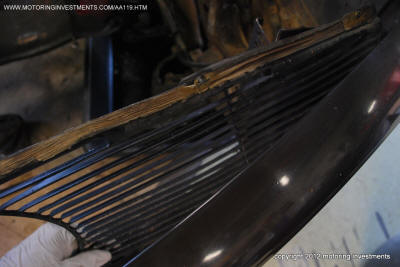 |
These
pictures to the left and right
display the tape that Mercedes Benz factory
technicians used to protect the body
and bug grills from rubs and rattles.
As per Motoring Investments' standards,
we will duplicate every detail the
factory technicians completed over 40 years ago. |
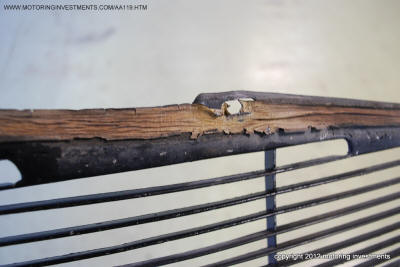 |
| |
|
|
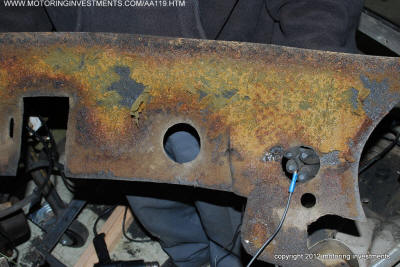 |
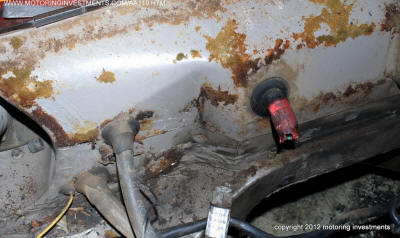 |
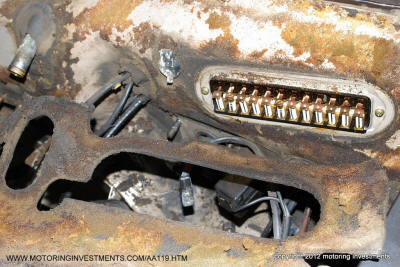 |
| |
|
|
 |
We carefully
removed the original firewall
pad. |
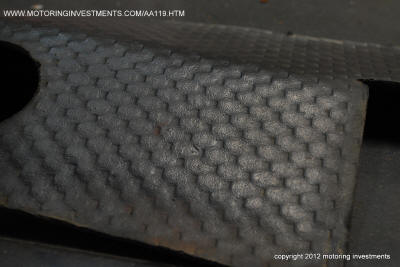 |
The undercarriage pictures below show the
rust free state of the car. We remove all suspension components and
rebuild the entire car.
|
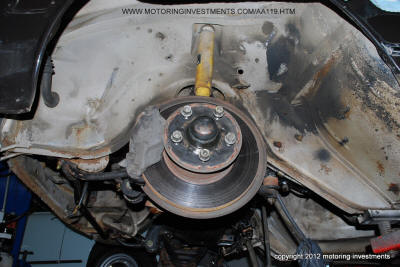 |
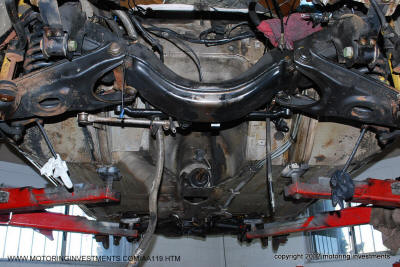 |
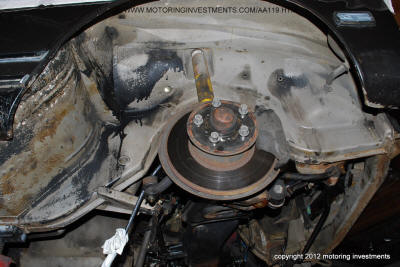 |
| |
|
|
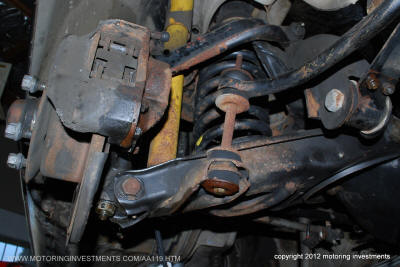 |
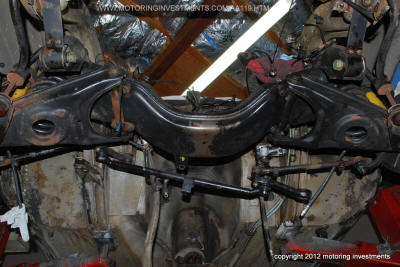 |
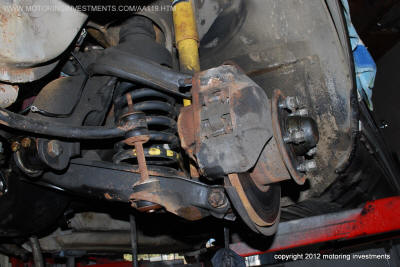 |
| |
|
|
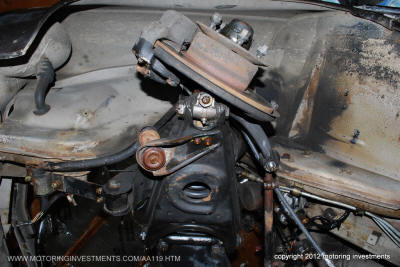 |
The pictures
shown here are
with the front
suspension in place, below we have
photos of the front suspension and
rear
end components
removed from the car.
These pictures are key to completing
a full inspection of the undercarriage and all
aspects of the rebuild can be addressed. |
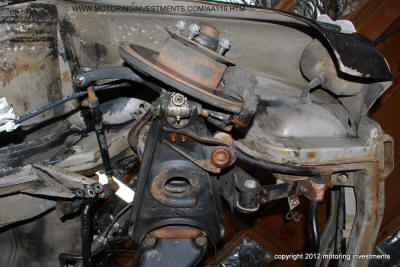 |
| |
|
|
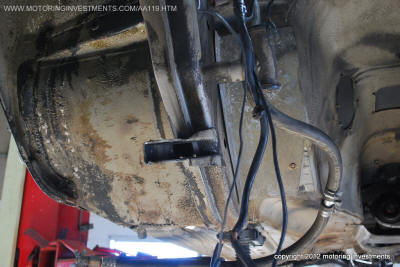 |
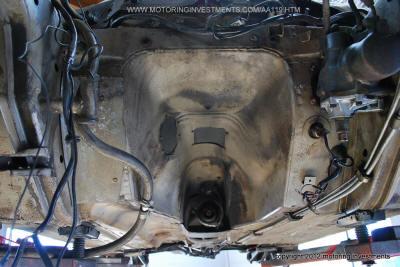 |
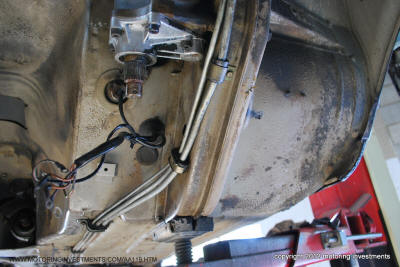 |
| |
|
|
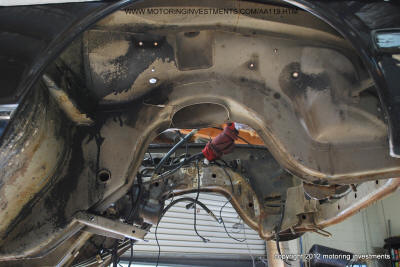 |
 |
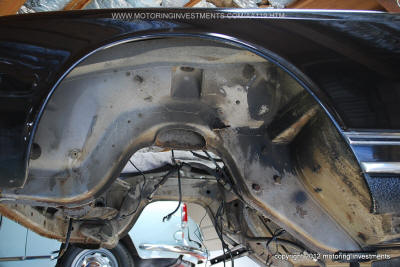 |
| |
|
|
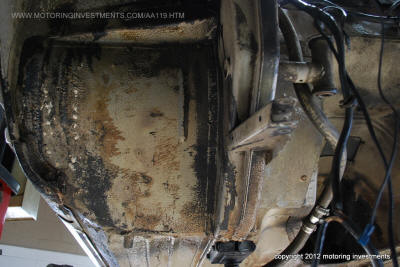 |
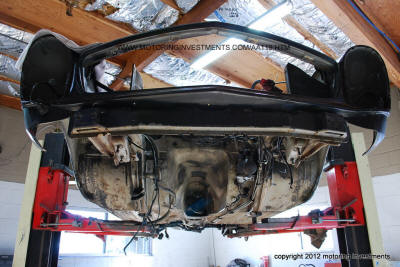 |
 |
| |
|
|
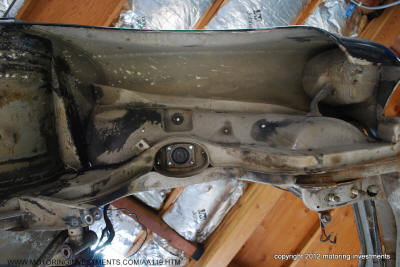 |
Below, the
fuel tank is removed. |
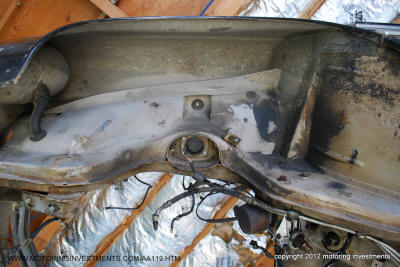 |
| |
|
|
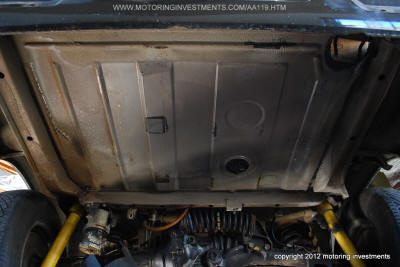 |
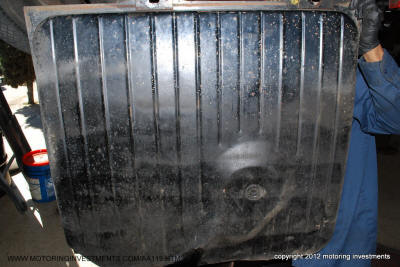 |
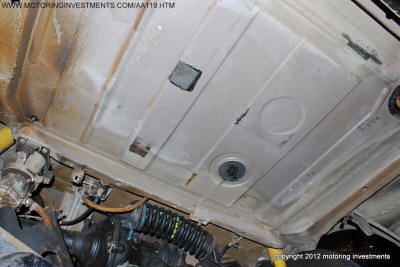 |
| |
|
|
 |
 |
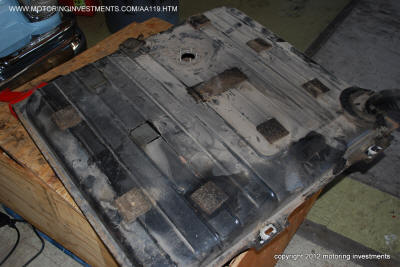 |
| |
|
|
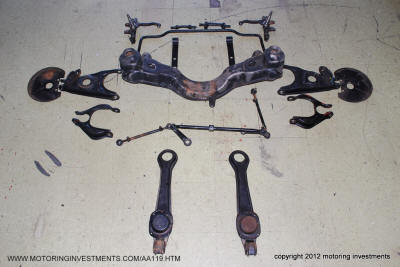 |
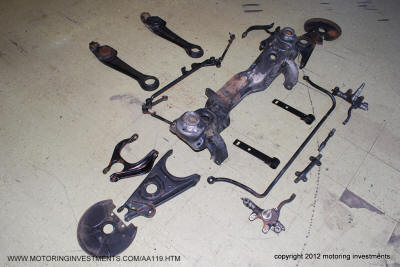 |
 |
| |
Before the powder coating
|
|
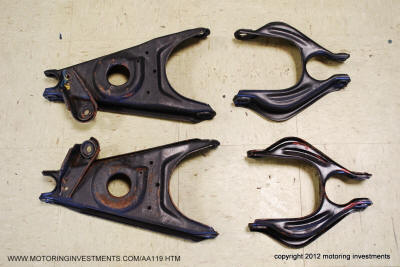 |
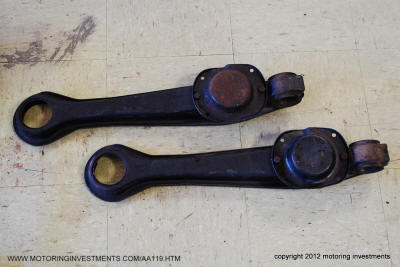 |
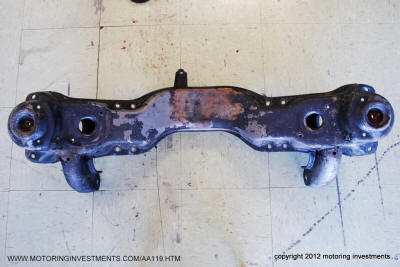 |
| |
|
|
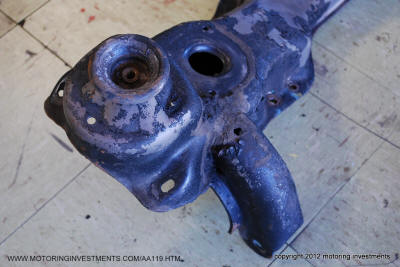 |
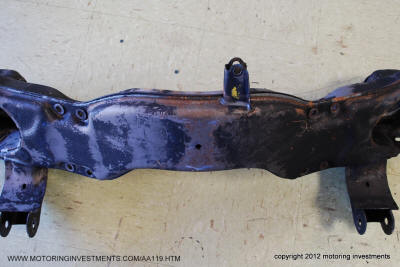 |
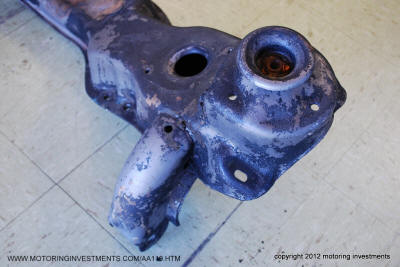 |
| |
|
|
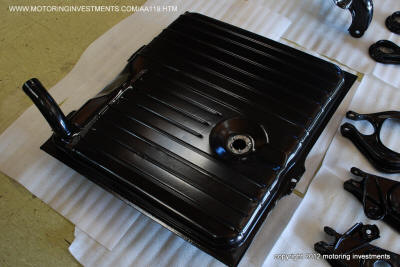 |
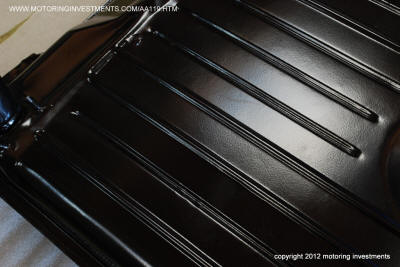 |
After the powder coating is completed
|
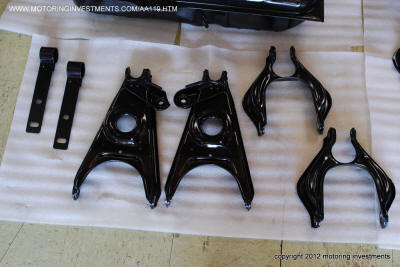 |
 |
 |
| |
The pictures
below, left and right
show the wheels and valves.
The correct air valve is taller than
the standard version to allow for
clearance from scratches
as you check and fill your tire pressure.
|
|
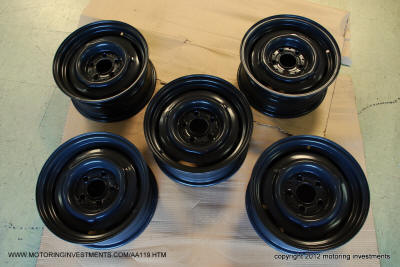 |
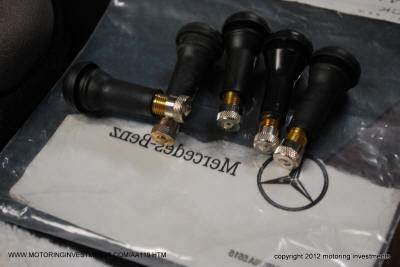 |
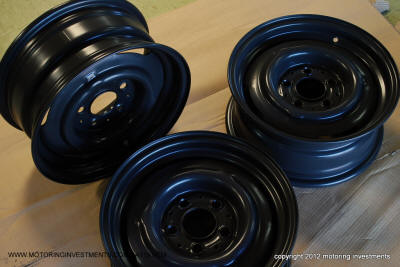 |
| |
|
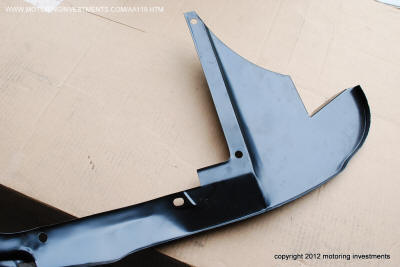 |
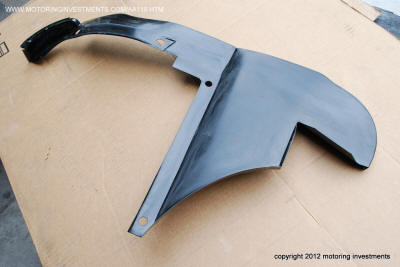 |
The pictures
above and below are of the wheelhouse partition panels. These panels are often
susceptible to
corrosion. They arrive from Mercedes Benz in a satin black finish with
no undercoating applied. We spray them
and paint them body color to match. |
 |
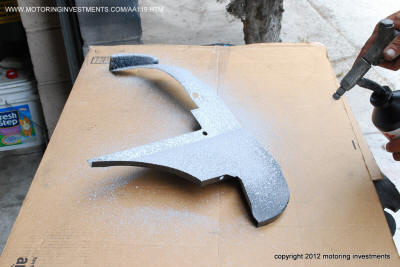 |
| |
|
|
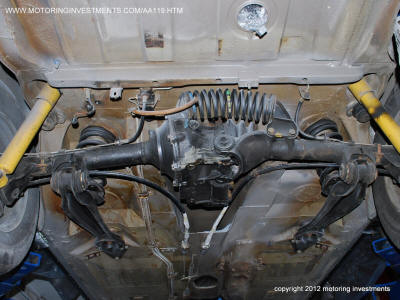 |
The rear end
will be removed.
Completely serviced and any
issues will be addressed.
The pictures on the right show the
bottom side of the trunk floor. Removing the
gas tank facilitates inspection and allows for
proper restoration of all components. |
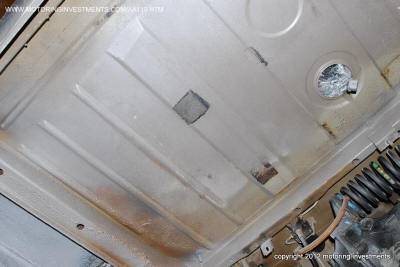 |
 |
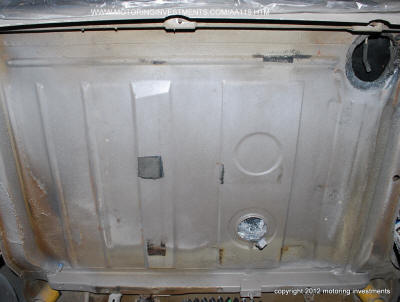 |
| |
|
|
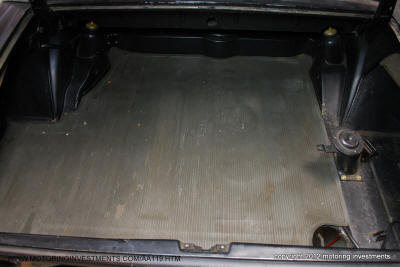 |
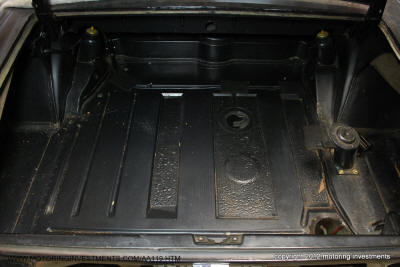 |
 |
| |
Notice the trunk floor and its condition.
This area is often prone to corrosion.
Even dry climate cars are known
to have light surface rust
from condensation improperly evaporating.
This trunk floor is in great condition.
|
|
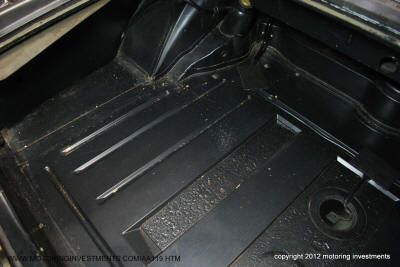 |
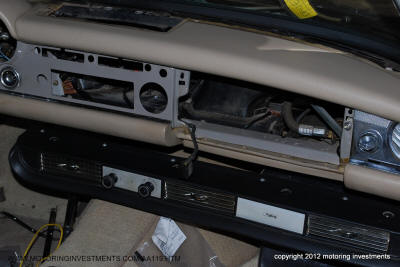 |
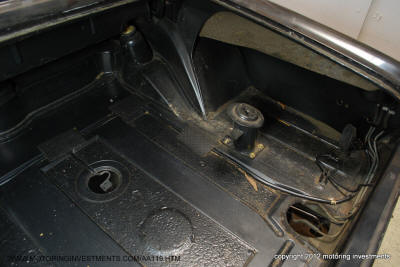 |
| |
The dash disassembly is
documented and parts are meticulously
inspected.
|
|
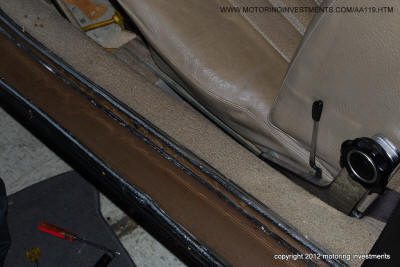 |
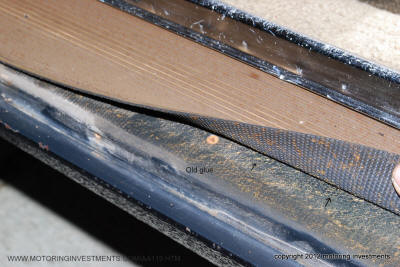 |
 |
| |
The
photographs above are of the door
threshold trim and pads. Notice the rare
color coded threshold sill pads?
Completely original and correct for this car.
|
|
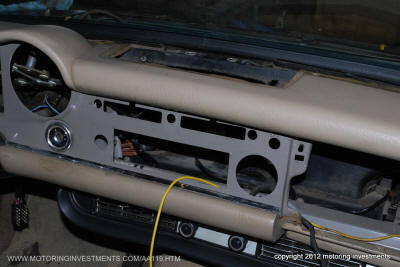 |
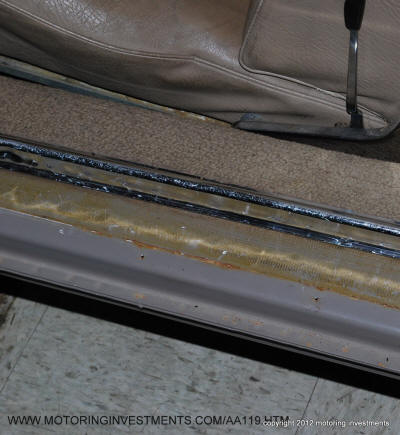 |
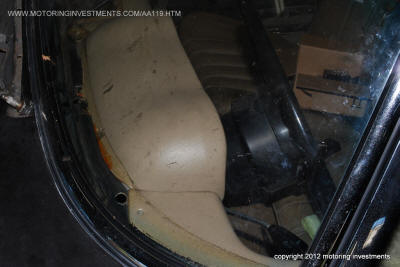 |
The above row displays pictures
of the interior and dash disassembly.
All switches, knobs, levers and electrical connections
are inspected, documented and reconditioned for serviceability.
|
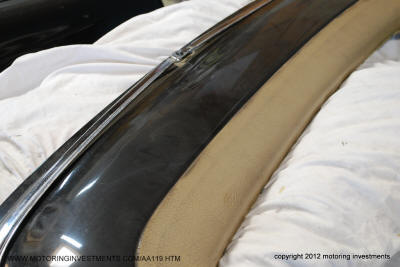 |
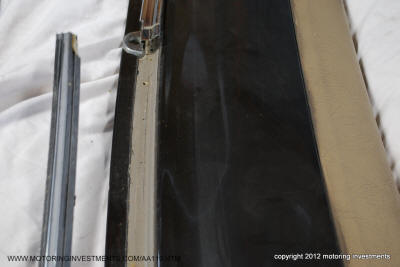 |
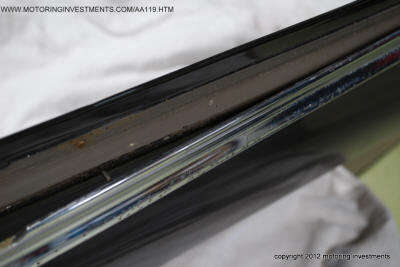 |
Removing all
the chrome trim, uncovers
more traces of the original gray-beige paint underneath. |
 |
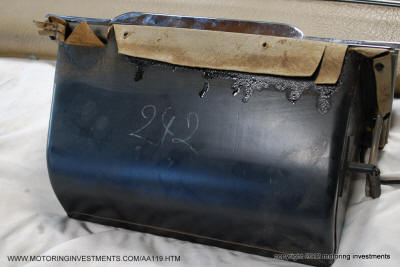 |
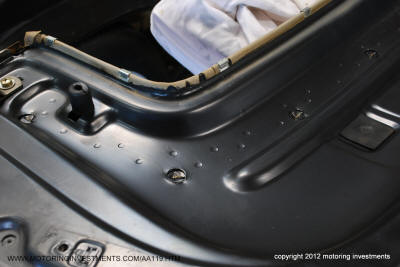 |
The number above is the
body number.
This sequence corresponds with all the
numbered panels on the car,
proving a body panels
(numbers matching) car. |
The # 242 is the
production number.
Notice all the interior panels are identified
with the same number. Door panels,
glove box, dash pieces and seats all
match. |
The underside of the
folding top compartment shows
the satin black original paint. |
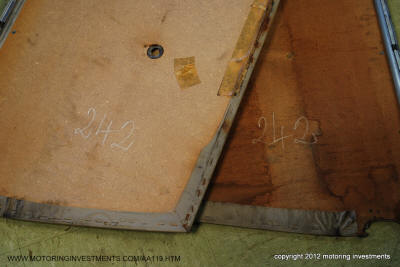 |
 |
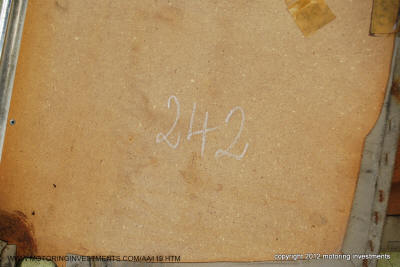 |
| The backsides of the door
panels. |
|
The photo below is of the
backside of the seat back panel. |
 |
Original
paint color code # 726 (Beige Grey)
Original color code for hard top # 726 (Beige Grey)
The data plate on the inner fender also displays
the production number ( #..242)
and the body number (#..121) |
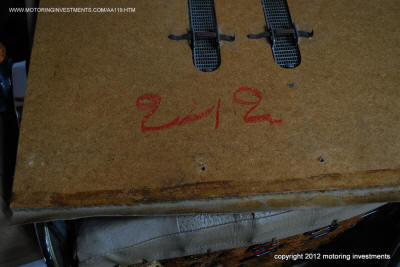 |
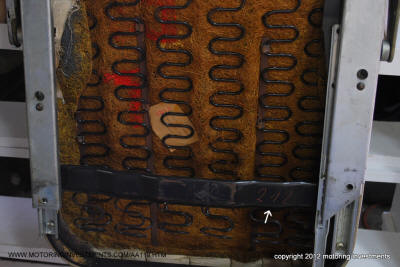 |
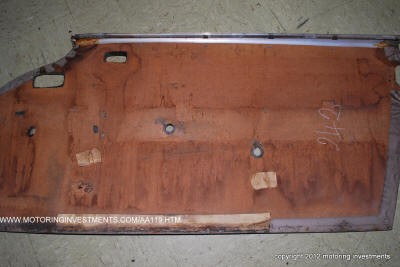 |
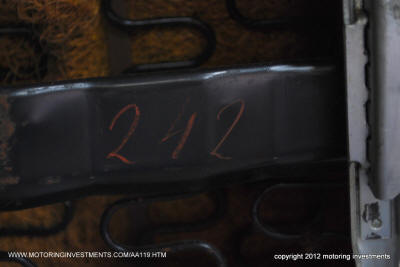 |
The production number
listed on the
inside of the seat frame. |
|
Close up picture
of the seat frame. |
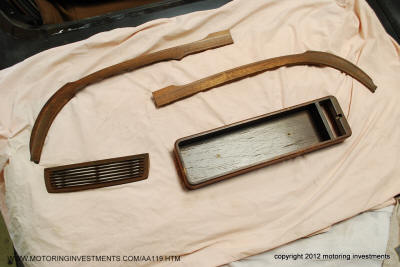 |
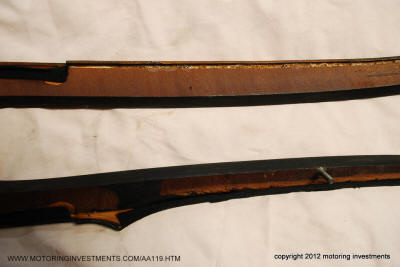 |
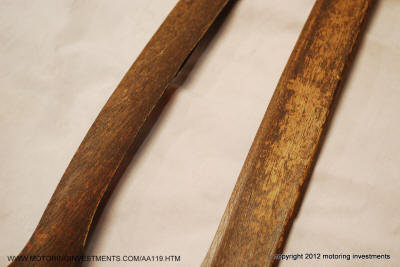 |
| |
Here are the "before" pictures of the wood.
It is carefully removed and veneered,
and refinished
to match the original color.
|
|
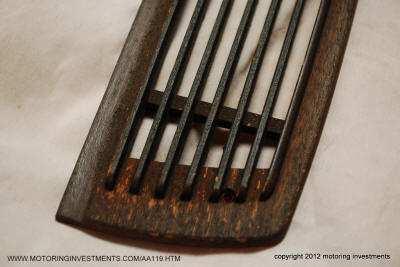 |
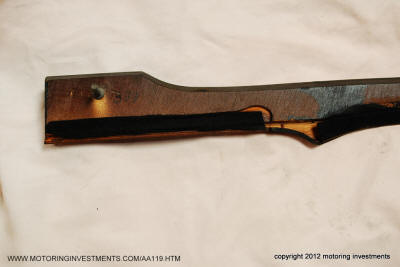 |
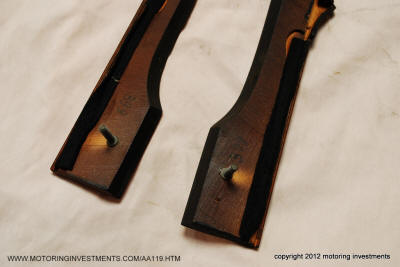 |
| |
|
|
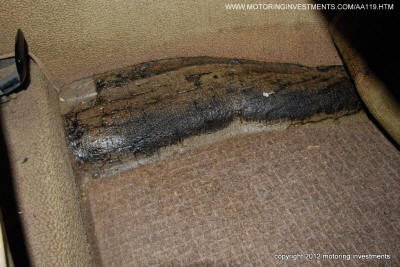 |
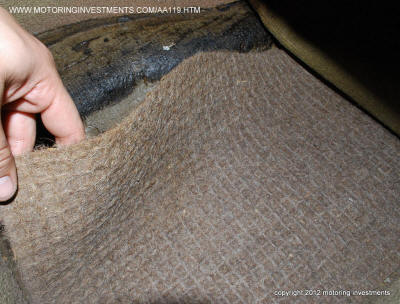 |
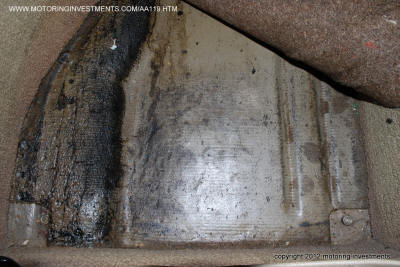 |
| |
|
|
 |
The pictures
above show the interior during
disassembly. Notice the waffle pattern floor
insulation in the photo above. This padding is
factory correct and was installed as an insulation
or sound deadening material.
The pictures above
also display the interior floor boards and their
exceptional and original condition. |
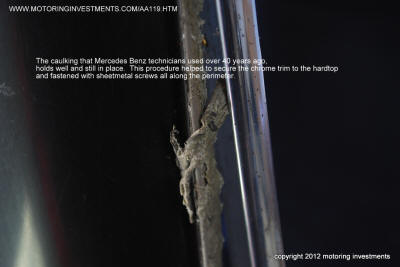 |
| |
|
|
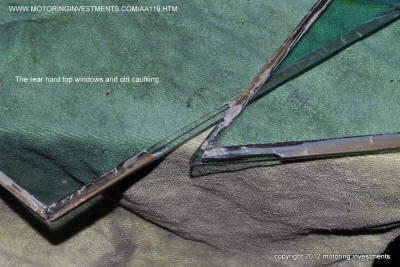 |
The caulking
applied by the
factory technicians, still in place for
over 43 years.
|
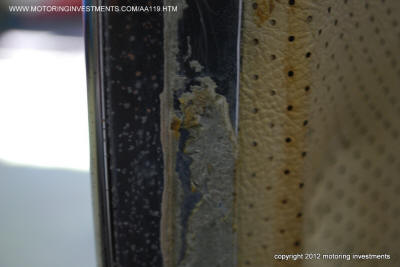 |
| |
|
|
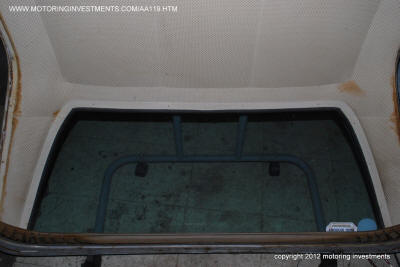 |
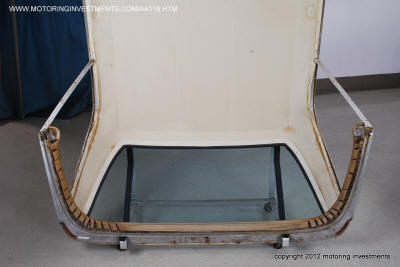 |
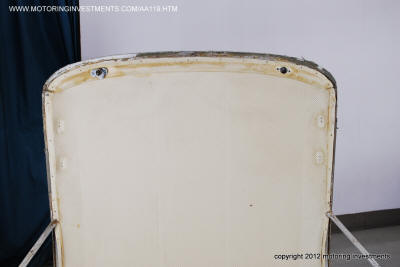 |
| |
|
|
 |
The headliner
in the before state. |
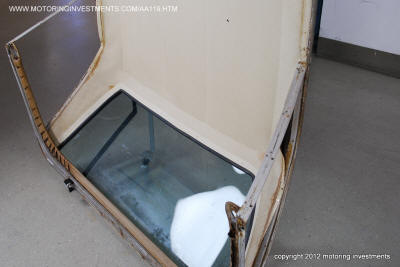 |
| |
|
|
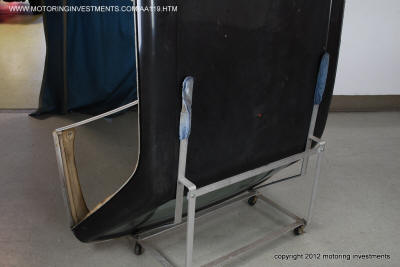 |
 |
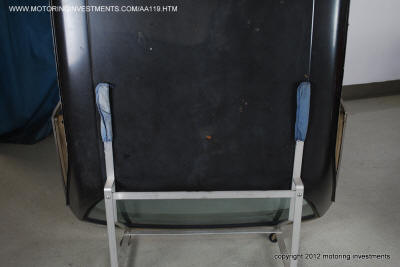 |
| |
|
|
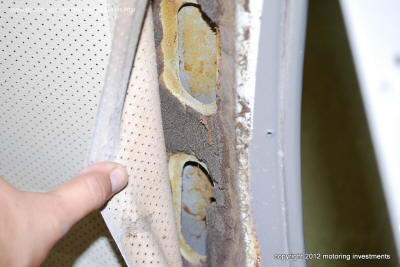 |
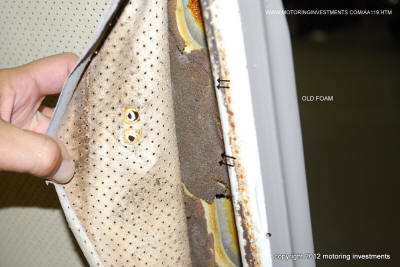 |
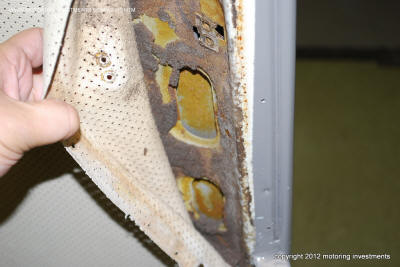 |
The pictures above show the old headliner foam that disintegrates over
time.
And below are images of the new foam going in place after the hardtop is
stripped and
cleaned.
|
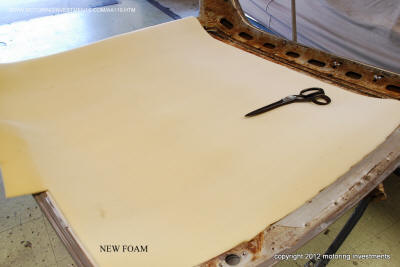 |
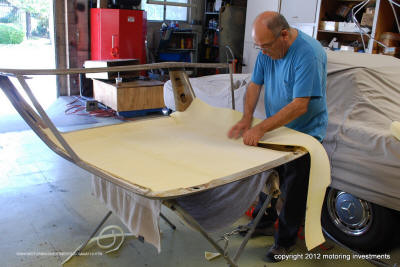 |
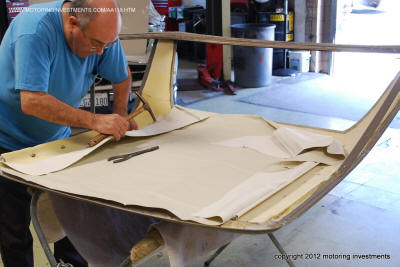 |
| |
|
|
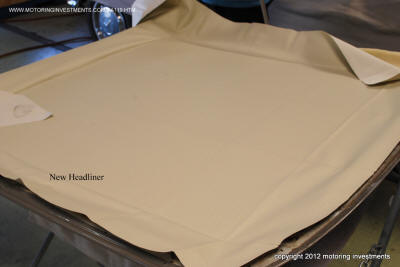 |
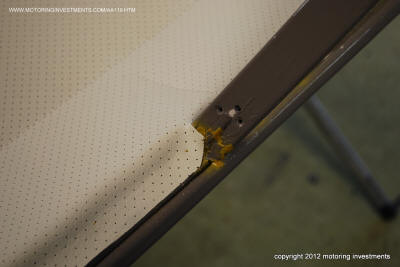 |
 |
| |
|
|
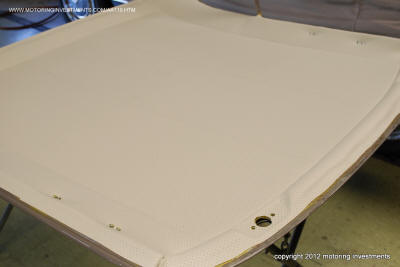 |
The new
headliner.
The picture below is a close up of the hard top
rear shelf area with the # 726
marked with a wax pencil from the factory.
This number corresponds with the color code. |
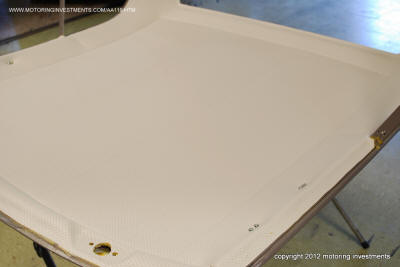 |
| |
|
|
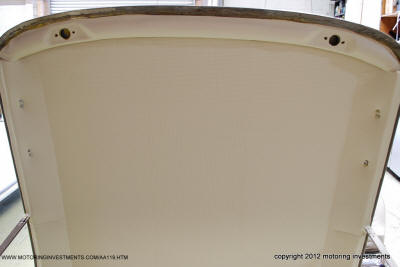 |
 |
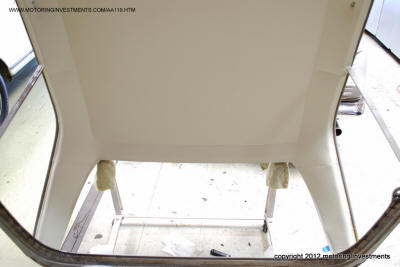 |
| |
|
|
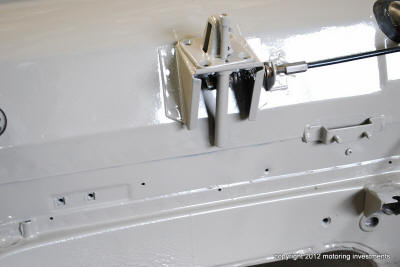 |
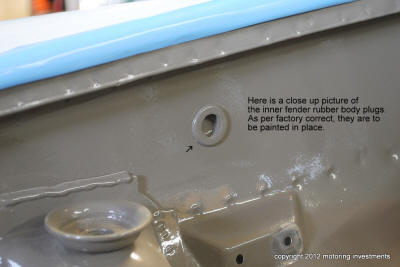 |
 |
The pictures above and below show us
the engine bay after the paint process.
Also notice the picture above of the
inner fender plugs painted in place.
|
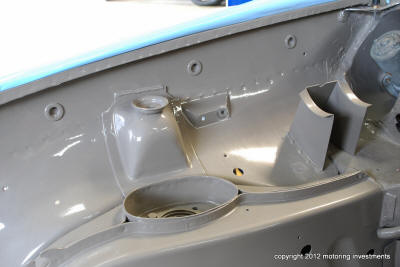 |
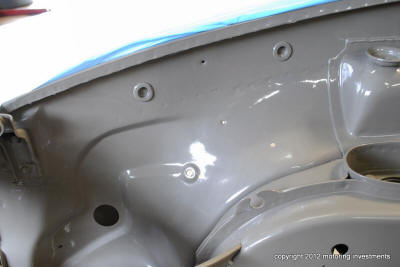 |
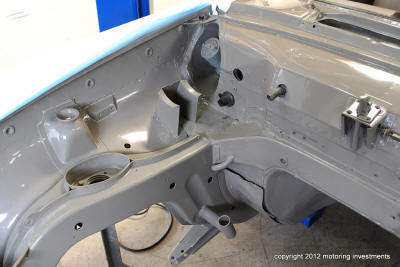 |
| |
|
|
 |
 |
 |
| |
The headlamp
bucket
pictured above is shown with the ground points
protected from the new paint. |
The wheel house
pictured below is painted
with the new partition panels.
|
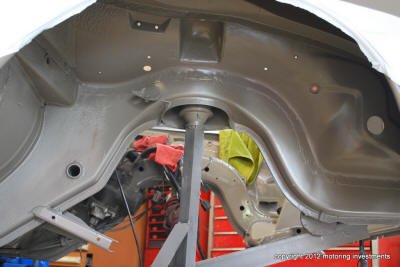 |
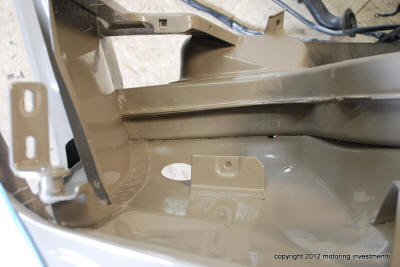 |
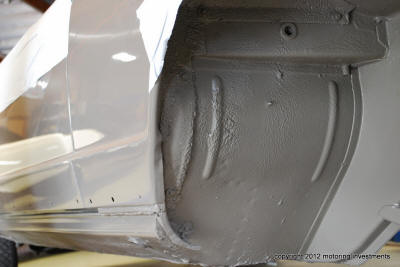 |
| |
|
|
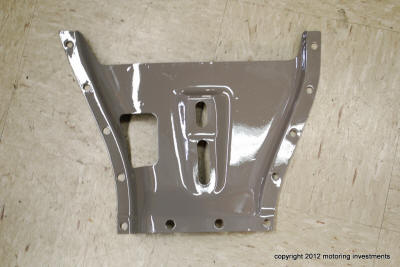 |
The
transmission mounting plate
is pictured to the left. This
plate is also a numbers matching panel
and painted to match the body color.
The fresh air flap
is pictured to the right. This
area is completely disassembled, painted,
and cleaned. Then reassembled with a
new cabin fresh air filter and all
new seals. The heater valve and O-rings
are also serviced at that time.
|
 |
| |
|
|
 |
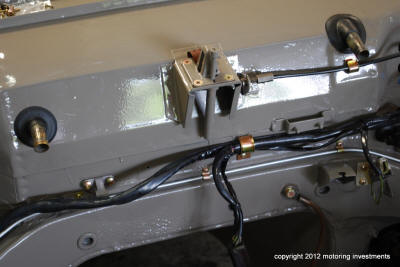 |
 |
| |
|
|
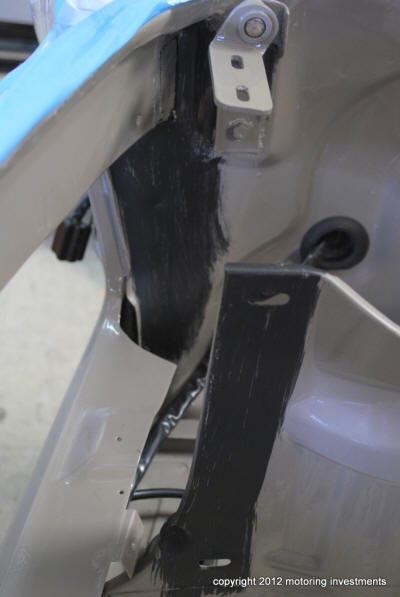 |
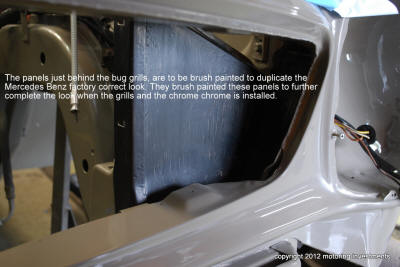 |
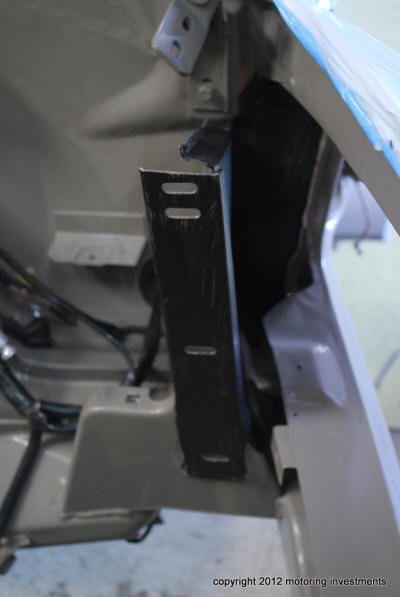 |
| |
|
|
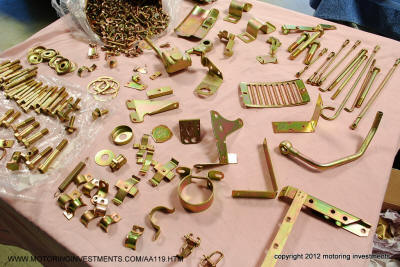 |
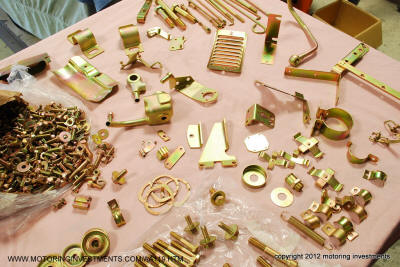 |
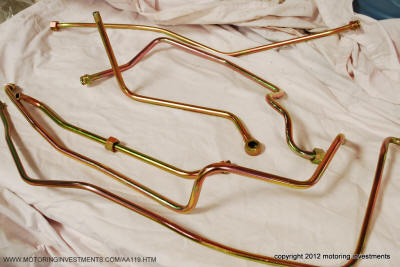 |
| |
The gold and silver cadmium pieces
are catalogued and re-plated.
Upon completion the pieces are
sorted and re-building can begin.
|
|
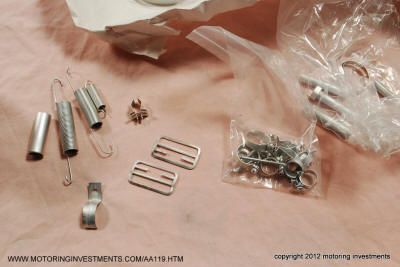 |
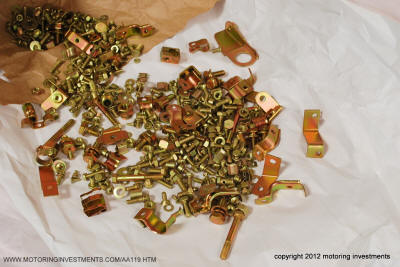 |
 |
| |
|
|
_small.JPG) |
New firewall
pad looks just like the original
pad from over 40 years ago. |
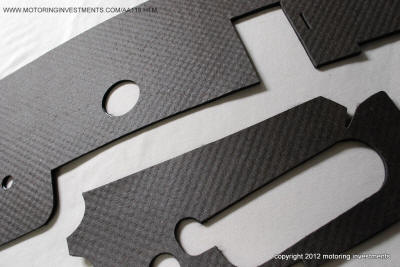 |
| |
|
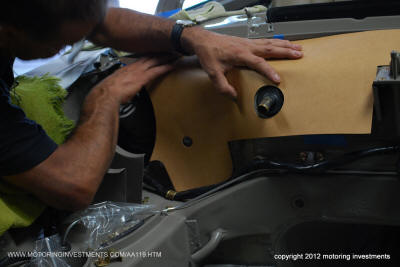 |
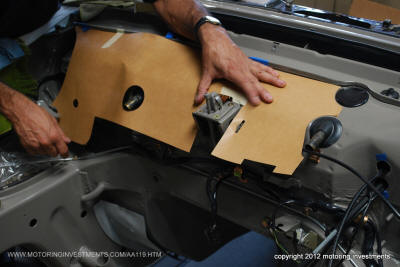 |
| |
|
 |
 |
| |
|
|
 |
 |
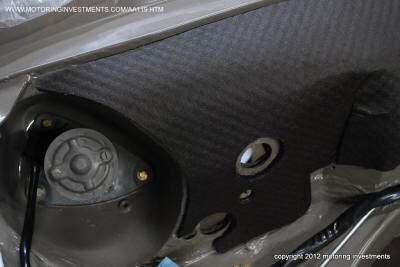 |
| |
The new
firewall grommets
to be installed. |
|
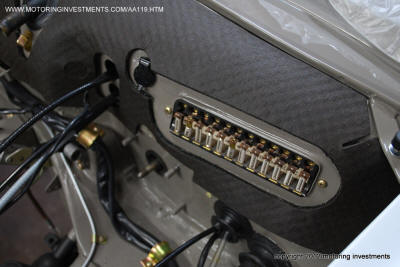 |
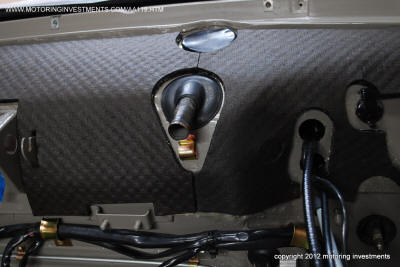 |
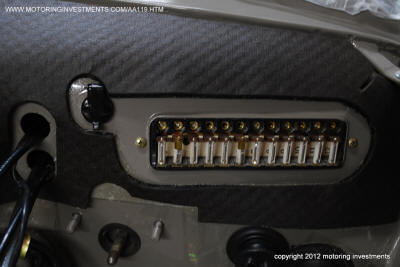 |
| |
Below are
pictures
of the engine bay components, after
the refinishing process. |
|
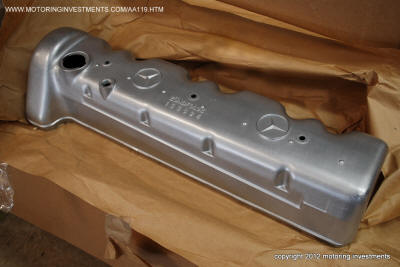 |
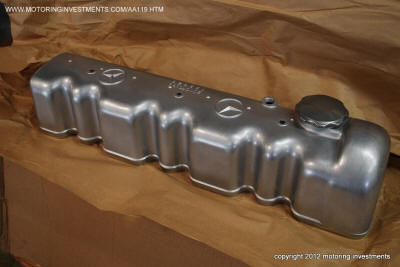 |
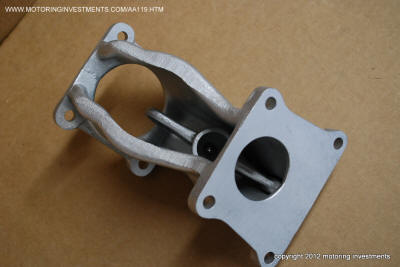 |
| |
|
|
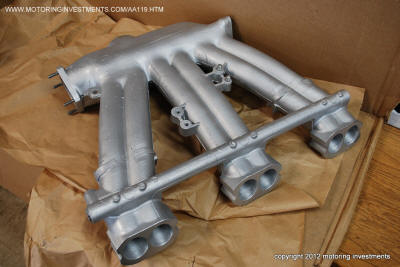 |
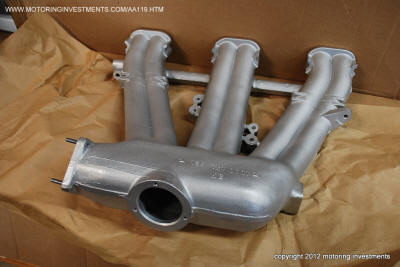 |
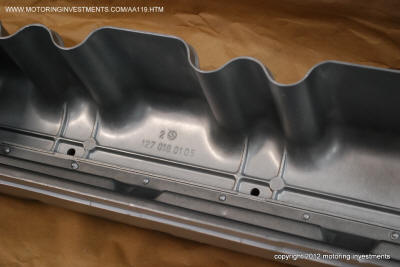 |
| |
The parts are ready for installation. These
parts have been cleaned
tumbled with a ceramic
media to achieve the correct finish.
|
|
 |
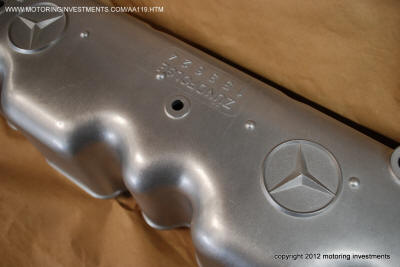 |
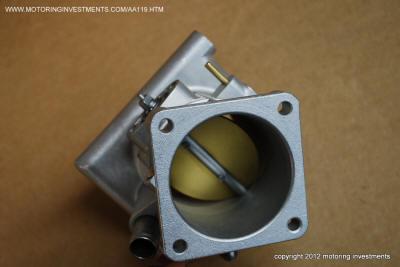 |
| |
Valve cover,
throttle body, brake booster
pedestal, accelerator linkage
and bases. Everything is redone. |
|
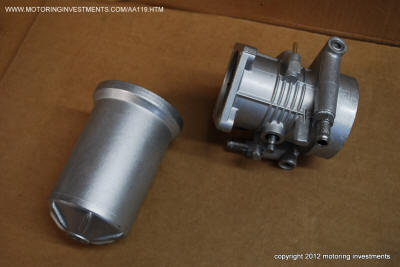 |
 |
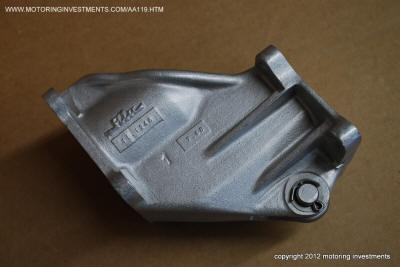 |
The pictures below are of the front suspension being assembled after we
sand blasted and powder coated to match the factory satin black.
|
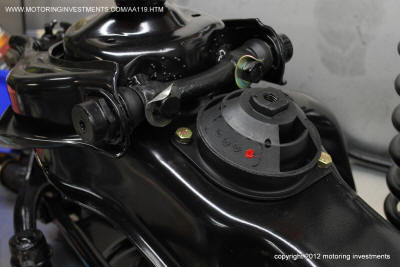 |
 |
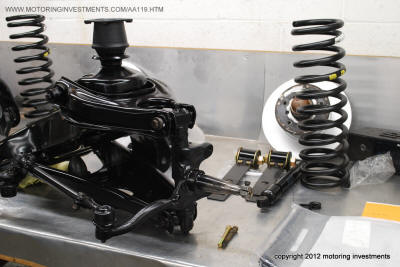 |
| |
|
|
 |
The
surrounding pictures are of
the front suspension during the
rebuilding process. |
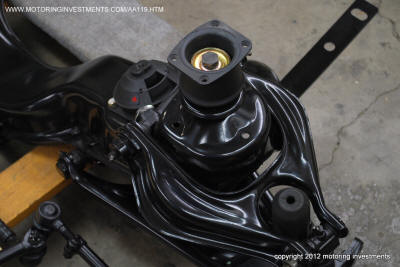 |
| |
|
|
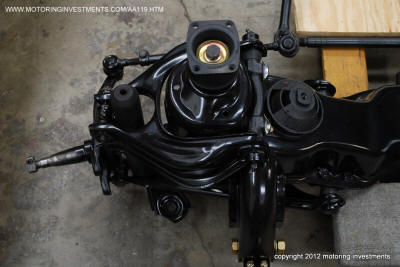 |
 |
| |
|
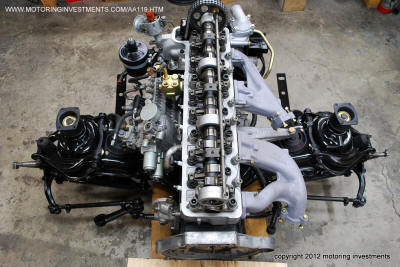 |
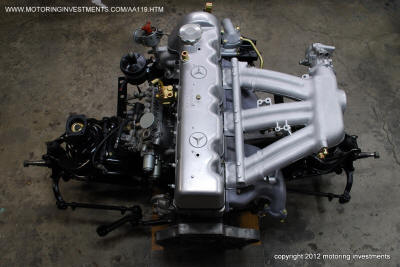 |
The view of the cylinder head and newly
coated
exhaust manifolds.
|
The picture
above is with the
valve cover and intake manifold
in place. |
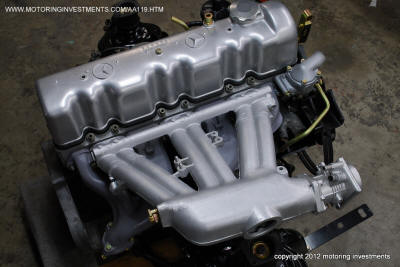 |
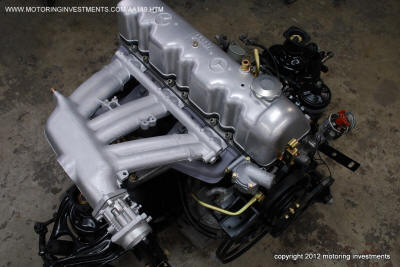 |
| |
|
 |
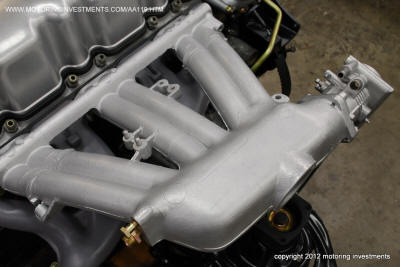 |
| |
The picture
below shows the engine mated to the freshly
rebuilt transmission. |
|
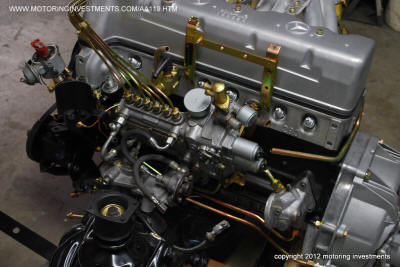 |
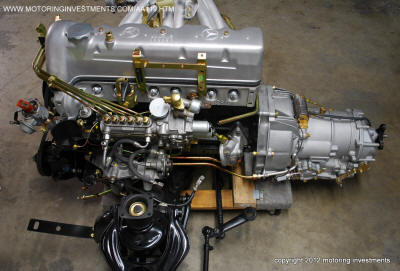 |
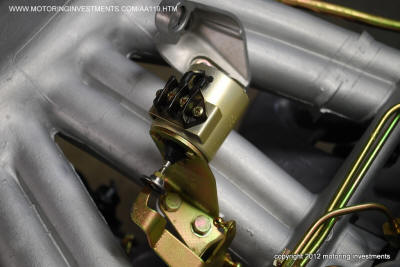 |
| |
|
|
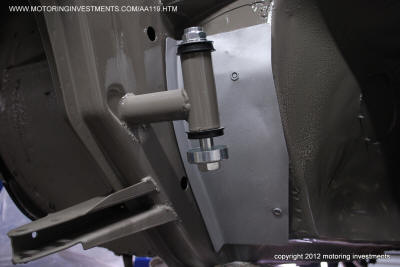 |
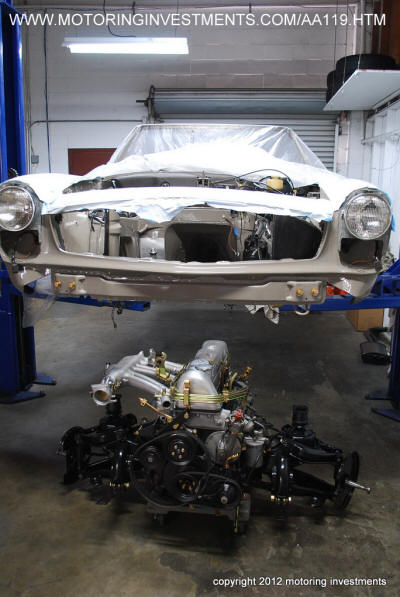 |
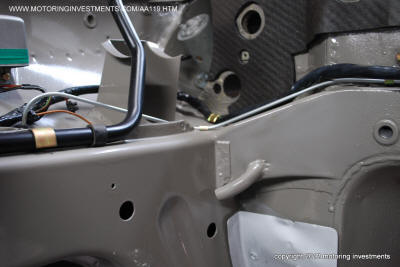 |
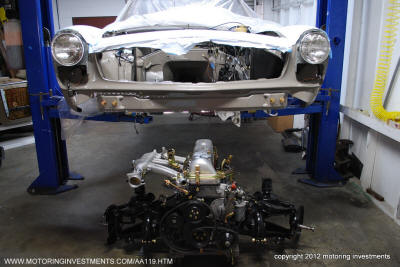 |
 |
| |
|
|
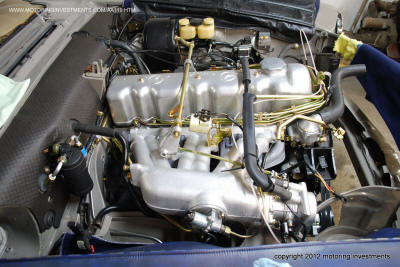 |
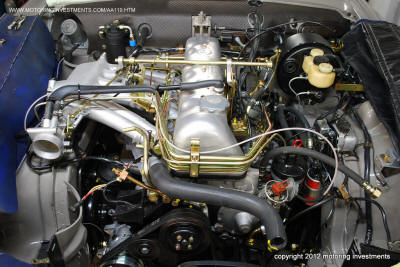 |
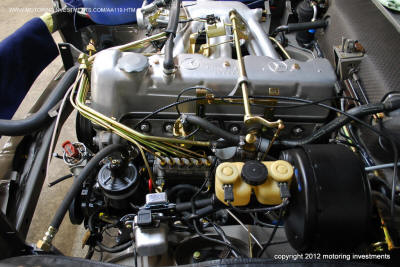 |
| |
|
|
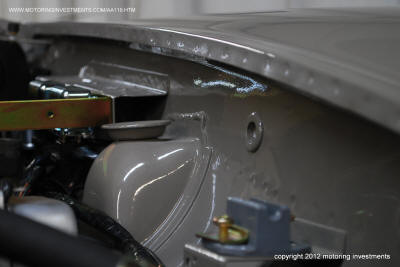 |
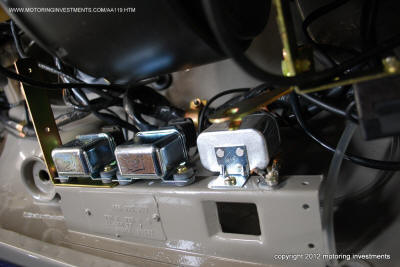 |
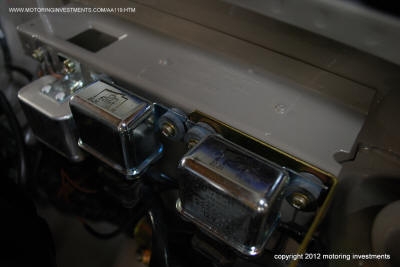 |
| |
|
|
 |
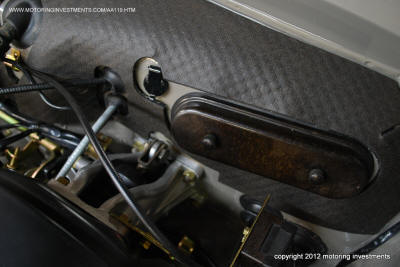 |
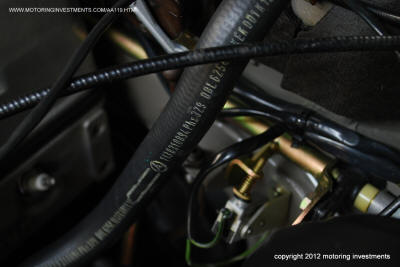 |
| |
|
|
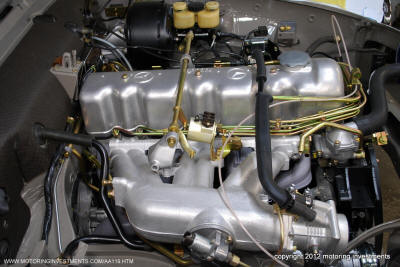 |
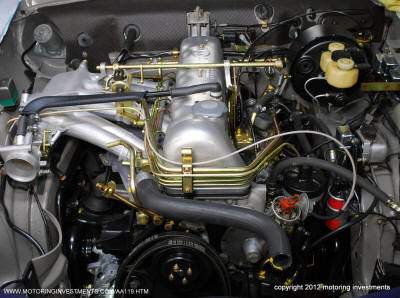 |
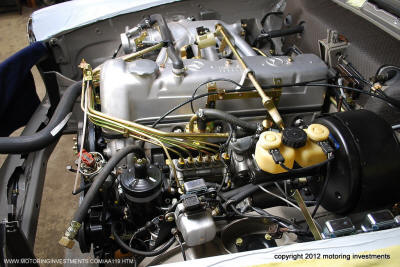 |
| |
|
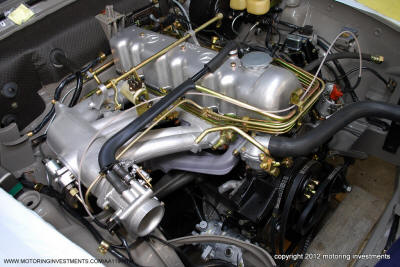 |
 |
| |
|
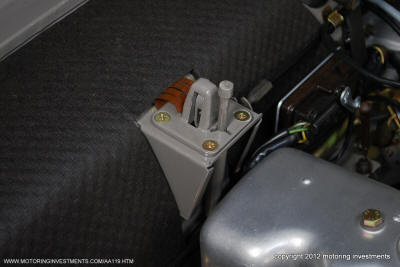 |
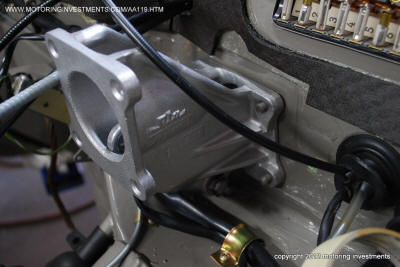 |
| |
|
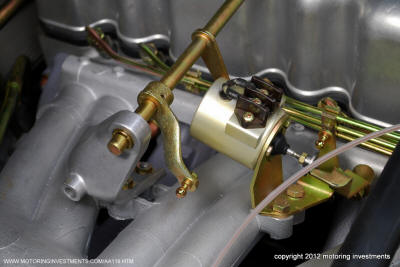 |
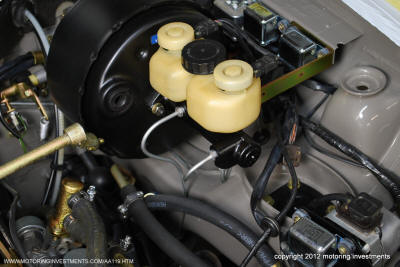 |
| |
|
|
 |
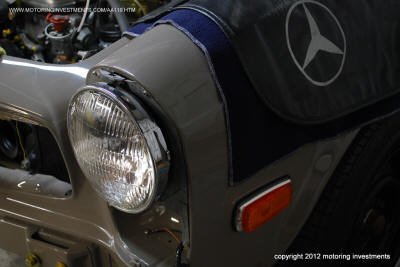 |
| |
|
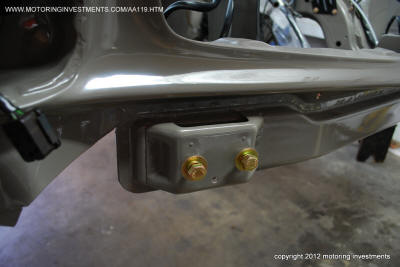 |
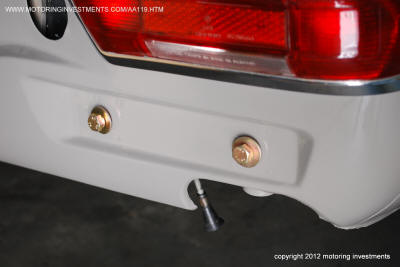 |
| |
|
|
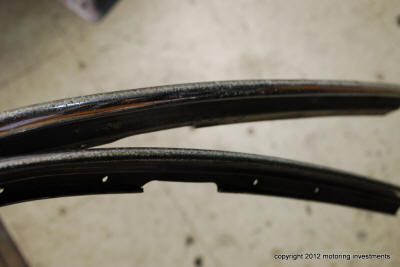 |
The picture
to the left and right are some examples
of the chrome before it is
stripped and re-plated.
The pictures below are of the exterior
and interior chrome after the
re-plating process is completed.
|
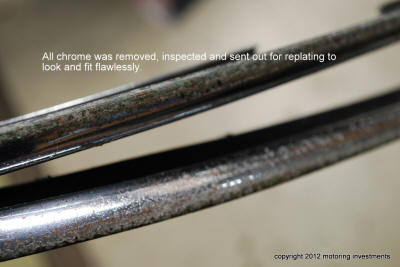 |
| |
|
|
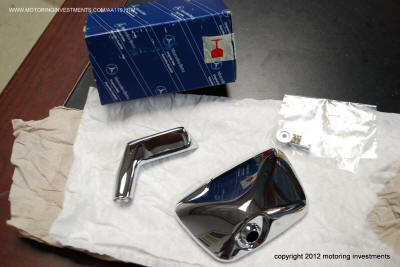 |
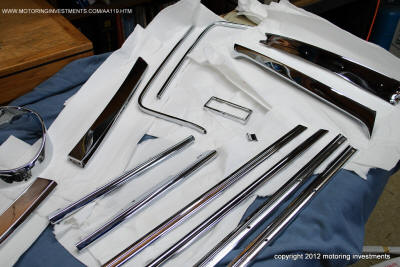 |
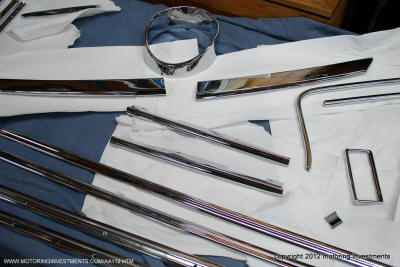 |
Pictured
above is
the new side rear view mirror from Mercedes. |
The ashtray bezel
is carefully
removed and re-plated to look like new. During reassembly
the tabs must he heated and bent back very slowly to avoid the
risk of breaking the delicate fasteners. |
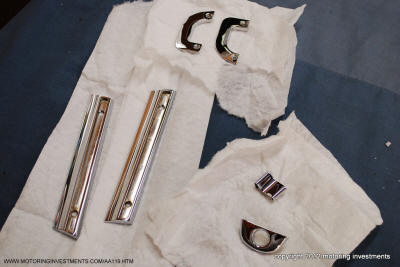 |
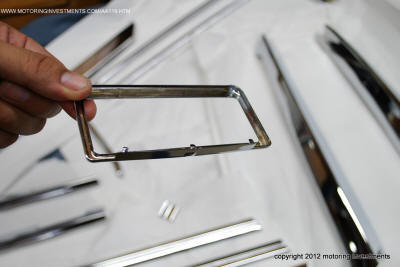 |
| |
|
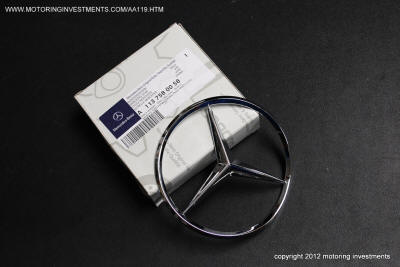 |
 |
The new trunk star and the new combination switch.
The switch controls the windshield wipers, turn signals and washer jets
as well.
These switches often need replacement from decades of use.
|
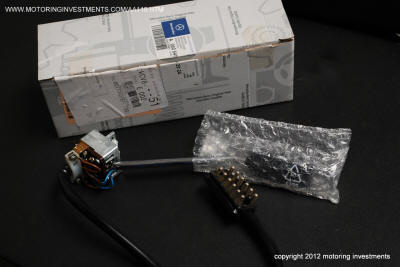 |
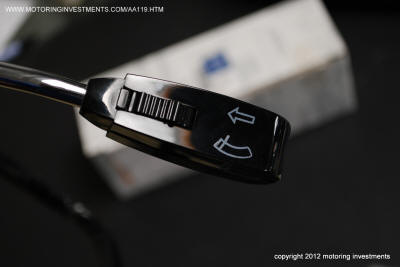 |
| |
|
|
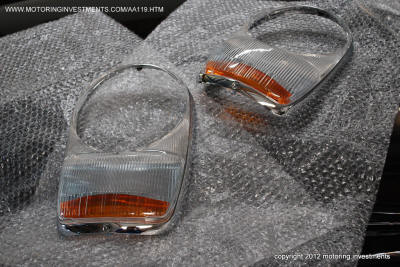 |
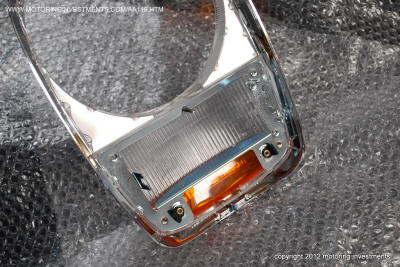 |
 |
| |
|
|
 |
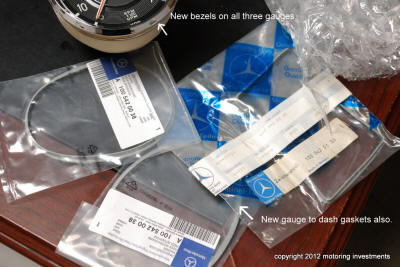 |
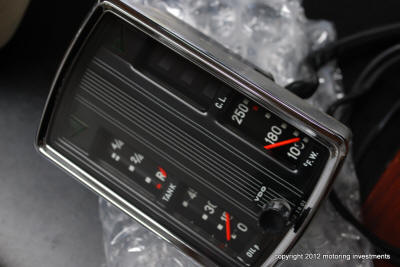 |
The gauges, top and
bottom.
Before installation and after....
flawless fit. |
All the instrument gauges are
serviced and fitted with new chrome bezels
along with new gauge seals
for an impeccable fit to the dash.
|
The picture below
is a close up of the reconditioned
clock. |
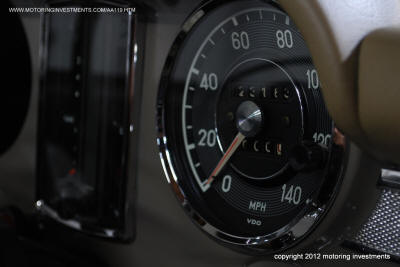 |
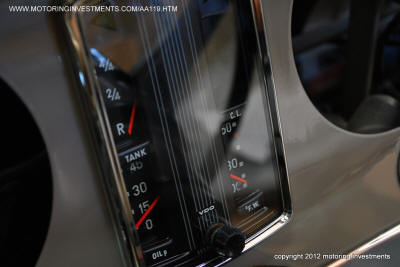 |
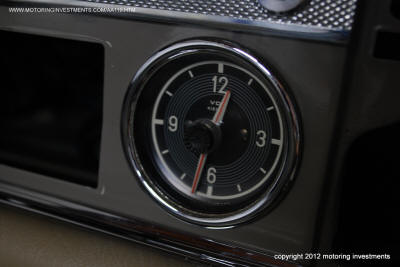 |
| |
|
|
 |
 |
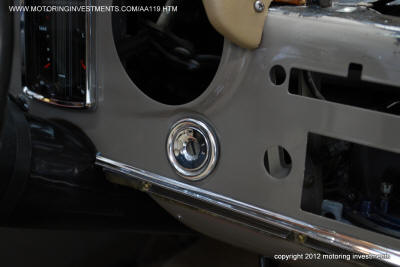 |
| |
|
|
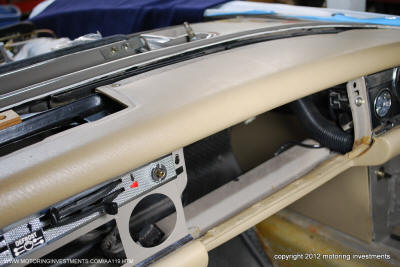 |
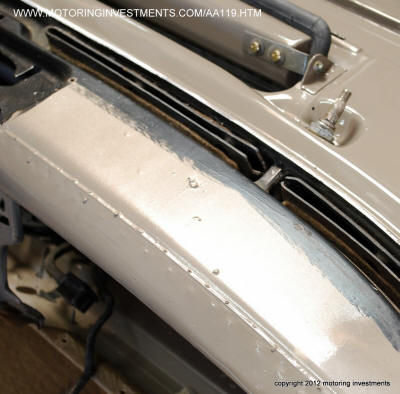 |
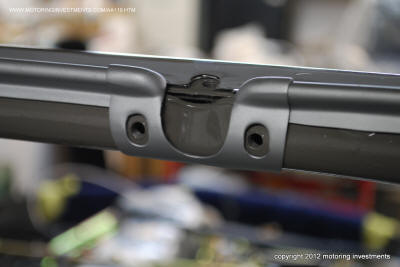 |
| |
|
|
 |
The original
Kangol seat belts
are also restored to look like new.
They will be re-webbed and the
chrome is re-plated
to look and feel fresh.
We duplicate every detail, from
re-applying the new decals on the buckles
to re-stitching the original labels. |
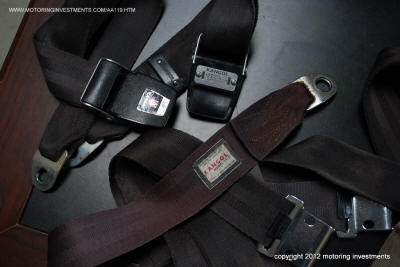 |
| |
|
|
 |
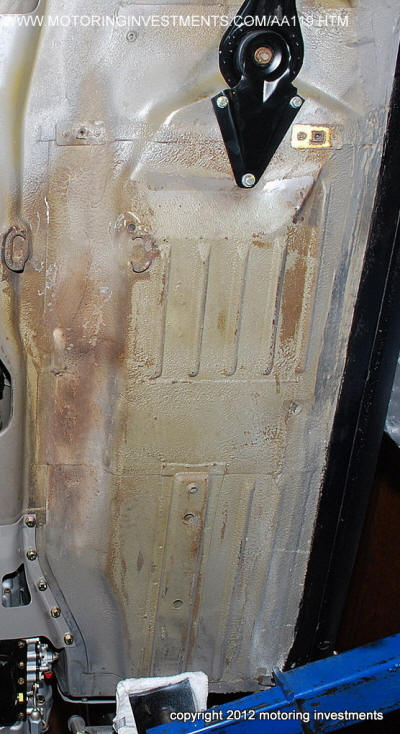 |
| |
|
|
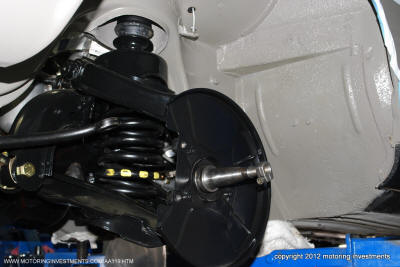 |
 |
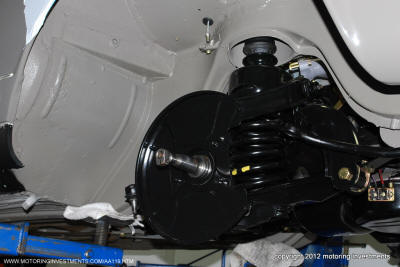 |
| |
|
|
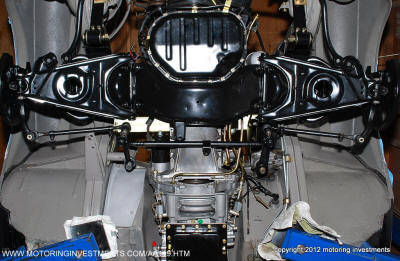 |
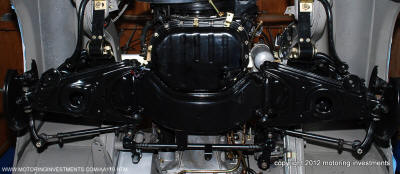 |
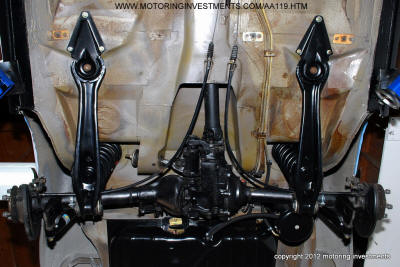 |
| |
|
|
 |
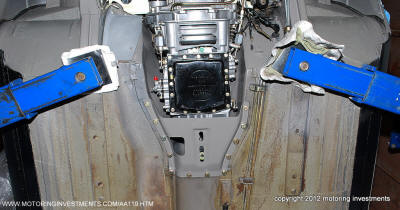 |
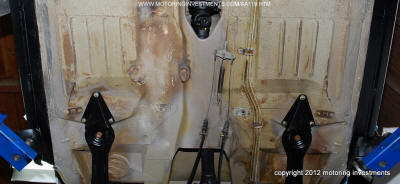 |
| |
|
|
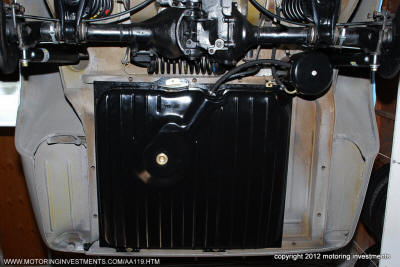 |
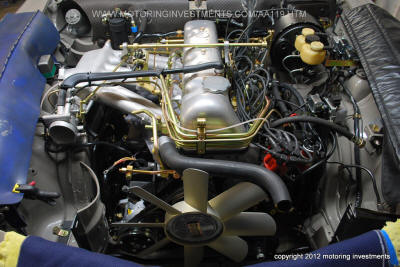 |
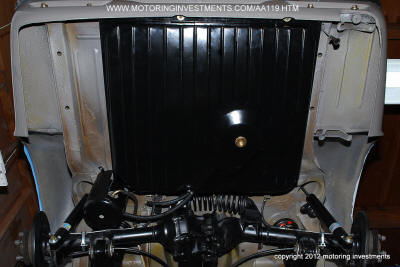 |
| |
|
|
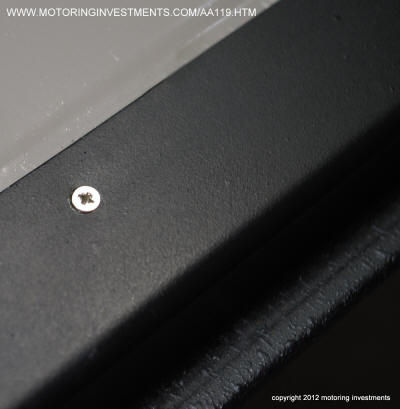 |
The pictures to the left and right
display the sheet metal screws
installed into the rocker panel covers. The
hardware is replaced with new fasteners. |
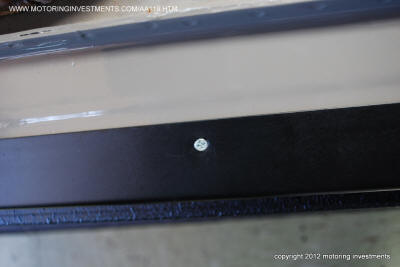 |
The pictures below are of the reconditioned
clock and dash going together.
|
| |
|
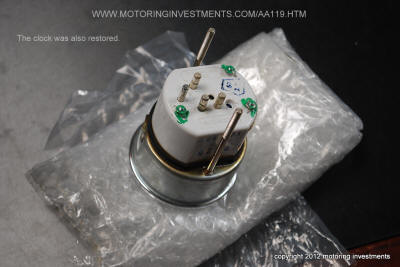 |
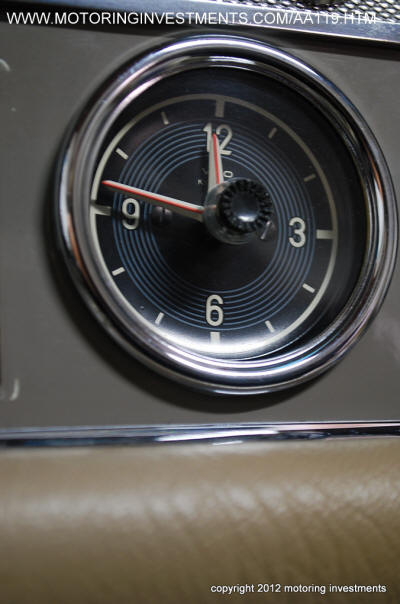 |
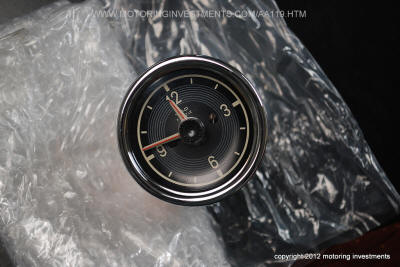 |
| |
|
|
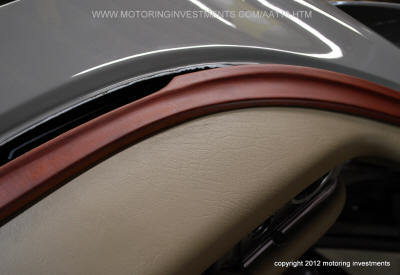 |
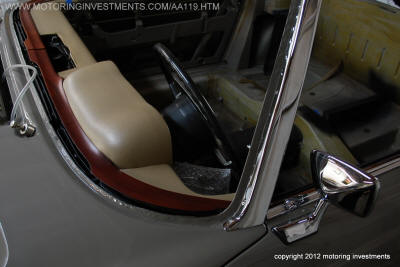 |
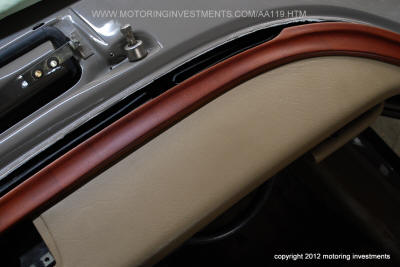 |
The pictures above and below show us the
progression on the topside of the dash.
The wood has also been restored and re-finished to the factory correct
look.
Below, we have pictures of the chrome being installed. Notice the
A-pillar chrome trims and the screws. They
must sit flush into the body and not protrude out from there respective
spot.
|
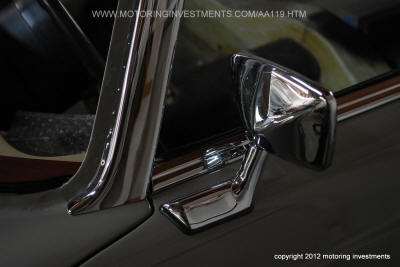 |
 |
 |
The pictures above and
below display
the exact fit the restoration is following.
All chrome, screws, wood, dash panels, etc.
fit perfectly. |
|
Another close up
view of the screws. To fit
like factory, a lot of
care goes into installing the fasteners. |
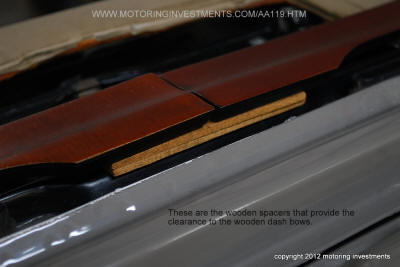 |
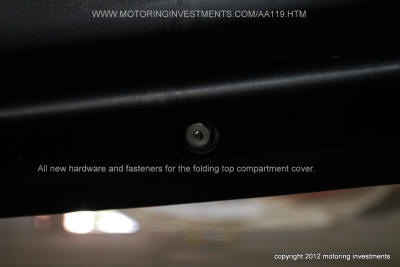 |
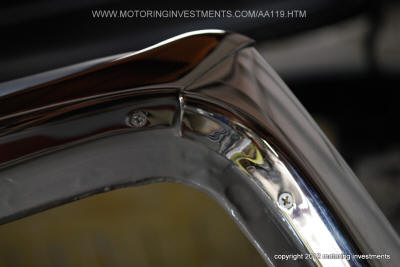 |
The pictures below are of the interior just
before carpet and interior panels installation. We duplicate the
satin black paint on the seat pedestals. The factory did this to hide
the
body color in the cockpit.
|
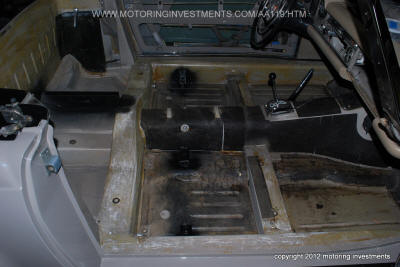 |
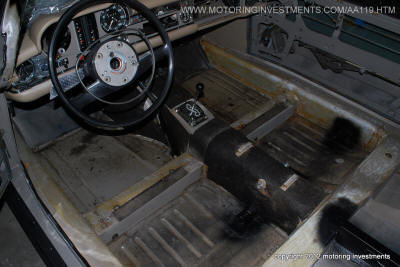 |
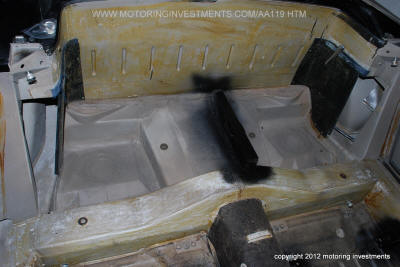 |
| |
|
|
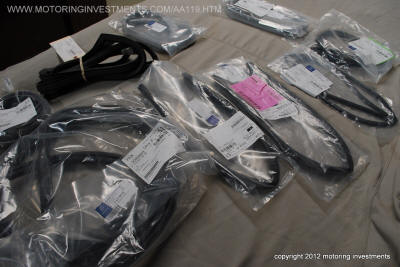 |
All new
weather seals, temperature levers,
and body seals.
All OEM Mercedes Benz
seals and parts to insure of a proper fit. |
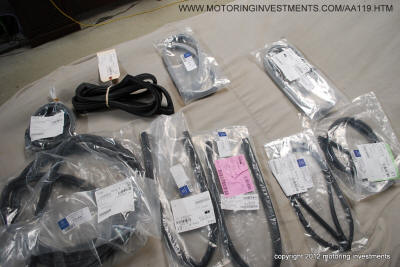 |
| |
|
|
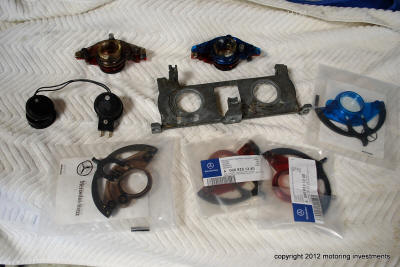 |
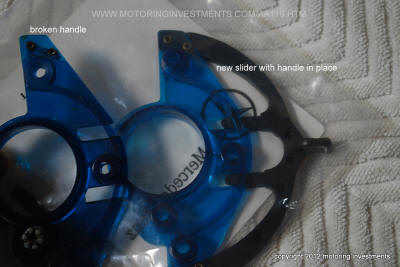 |
 |
| |
|
|
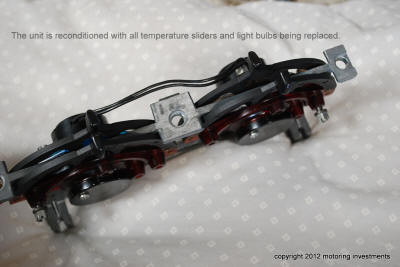 |
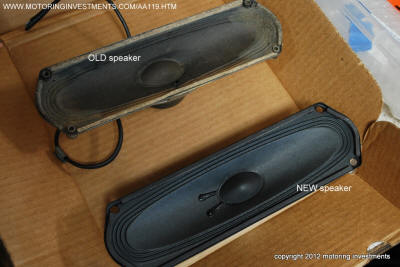 |
 |
The oval speaker from the topside of the
dash is replaced with a new one.
|
| Re-trimming
the rear ledge of the hardtop |
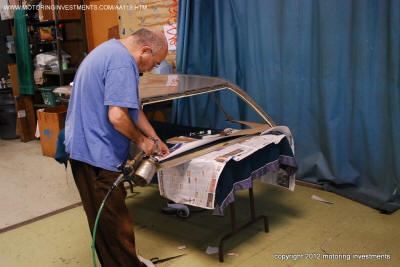 |
 |
| |
|
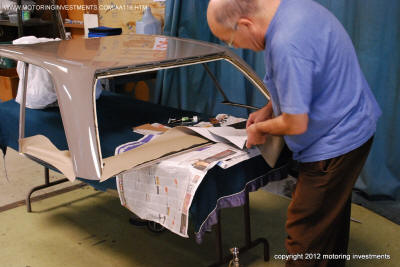 |
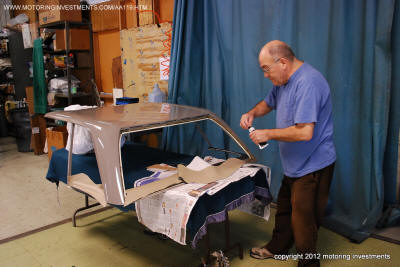 |
| |
|
|
_small.JPG) |
_small.JPG) |
| |
|
|
_small.JPG) |
_small.JPG) |
_small.JPG) |
| |
|
|
The undercarriage pictures below show the
exhaust parts as well as hanging the
system in place.
|
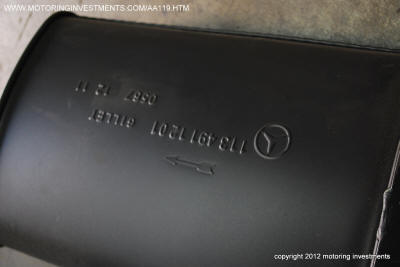 |
 |
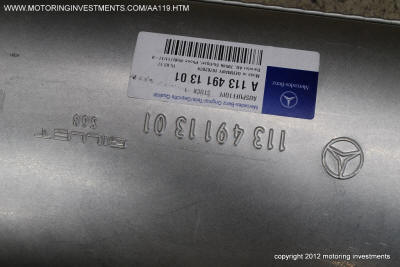 |
| |
|
|
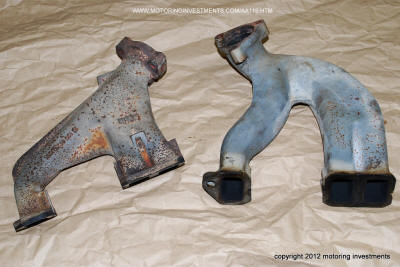 |
The photos to
the
left display the exhaust manifolds
before being sent out for coating. The photo
on the right shows the manifolds
coated in a high grade aerospace
ceramic finish. This process lowers the
temperature in the engine bay and extends the life of neighboring
components. |
 |
| |
|
|
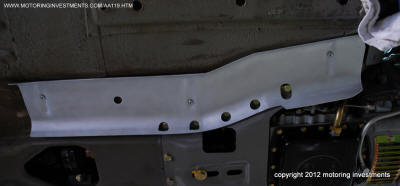 |
The pictures above and below are of the
exhaust system parts. The exhaust system is
first hung in place then removed to be
welded together for an exact fit.
The underside heat shield
(pictured on the left) that protects the
floor from the
exhaust temperature is in place.
|
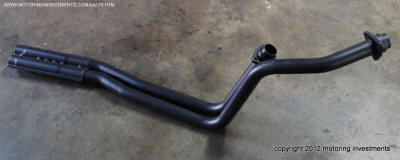 |
| |
|
|
_small.JPG) |
 |
_small.JPG) |
| |
All OEM factory
correct replacement parts. |
|
_small.JPG) |
_small.JPG) |
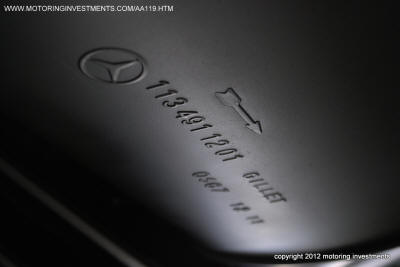 |
| |
Notice the lines of the exhaust pipes and
their relationship to the rest of the
undercarriage. A perfect fit.
|
|
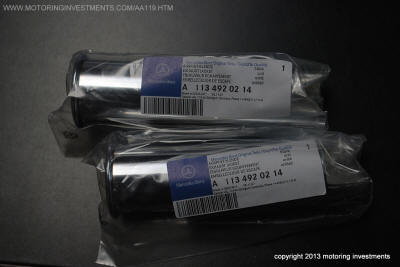 |
 |
| |
|
|
_small.JPG) |
_small.JPG) |
_small.JPG) |
| |
|
|
_small.JPG) |
_small.JPG) |
_small.JPG) |
| |
|
|
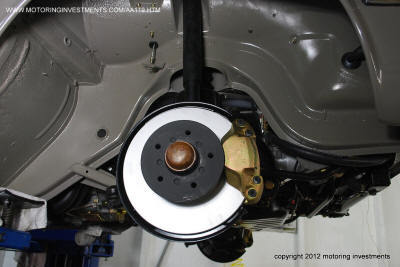 |
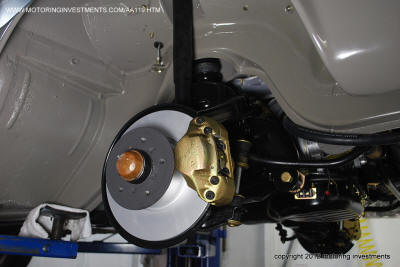 |
 |
| |
|
|
 |
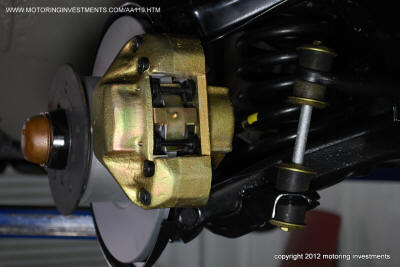 |
| |
|
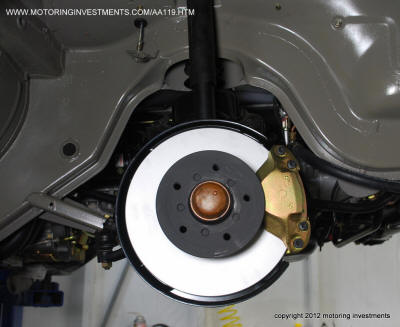 |
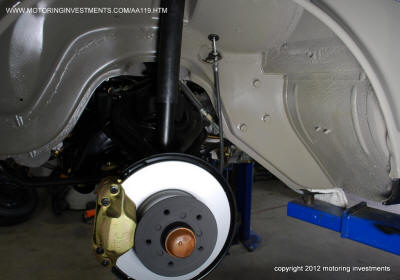 |
The pictures above are of the front brake
discs and calipers.
The photos below show us the rear brake discs, calipers and wheel wells.
|
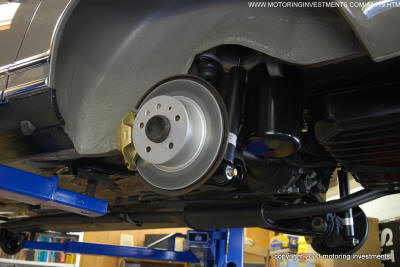 |
 |
| |
The picture below shows us the rear deck
lid in the completed state.
|
|
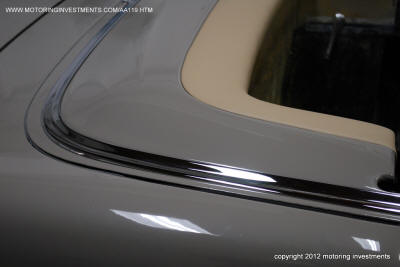 |
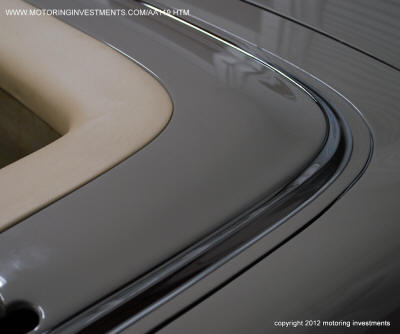 |
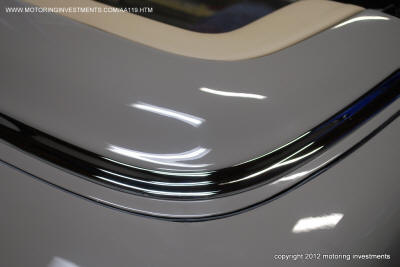 |
| |
|
|
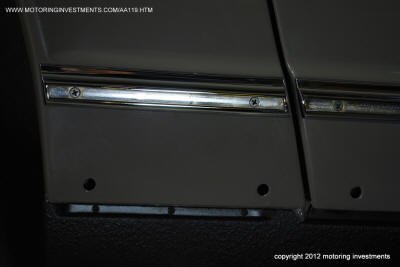 |
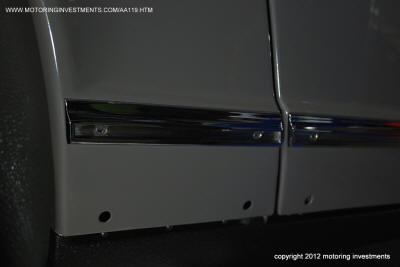 |
The pictures above display the chrome body moldings. These are re-plated
and installed
with all new screws and hardware. Notice the picture below, the screws
sit
flush into the chrome trim. The rubber profile, next to be installed, will now
sit flush into the trim channel.
|
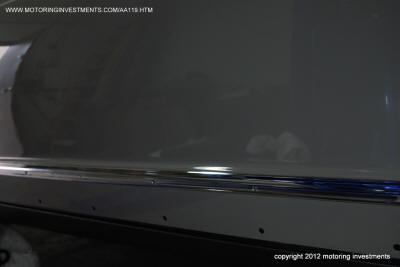 |
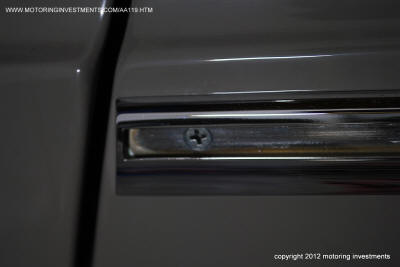 |
| |
|
|
 |
The photos to
the left and right are
of the bug grills, before we refinished
them. |
 |
| |
|
|
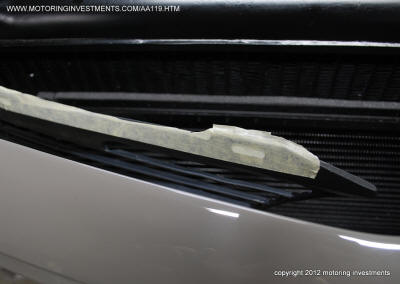 |
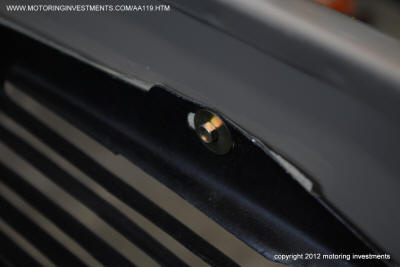 |
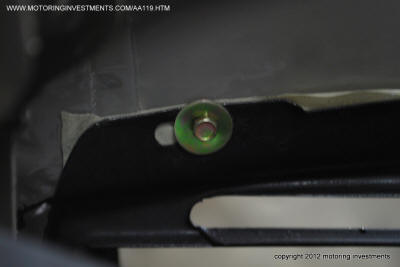 |
| |
The photos above are of the bug grills refinished
and installed into the car.
|
|
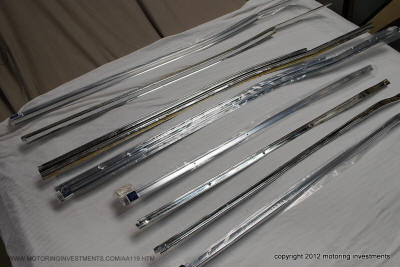 |
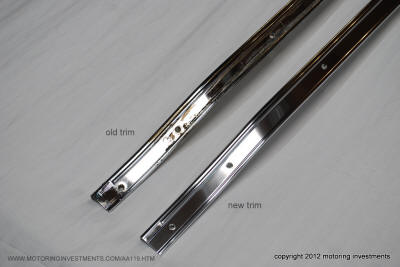 |
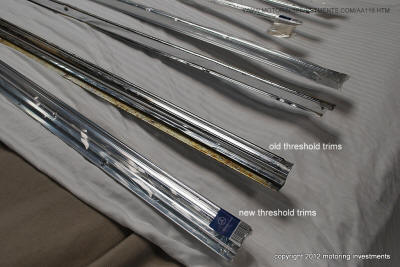 |
| |
The
surrounding photos are of the door
threshold trim sets, both new and old. |
|
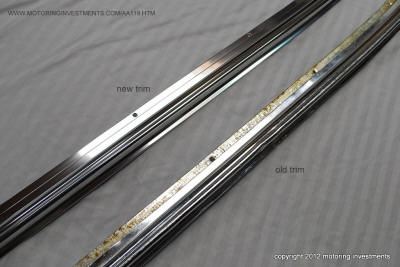 |
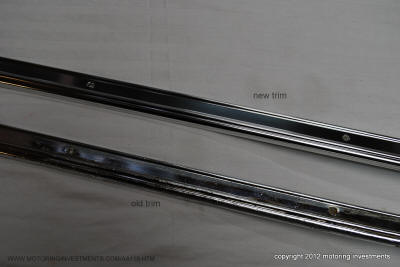 |
 |
| |
|
|
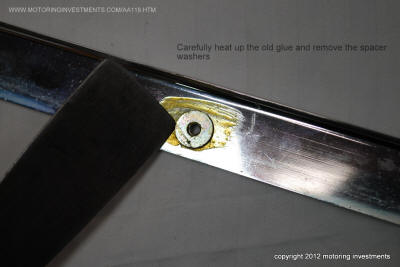 |
 |
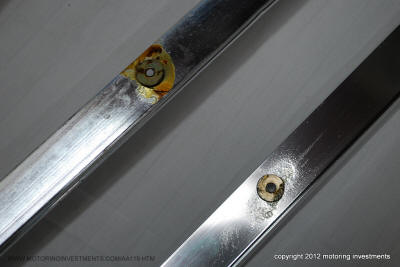 |
| Spacer washers behind the
trim |
When preparing the trims for installation
we carefully remove the washers behind
the original outer trims. Their
purpose is to provide spacing from the
body to the
rocker panel covers.
|
The above picture is a
close up of a new trim with washer
in place along with
an old trim. |
| |
|
|
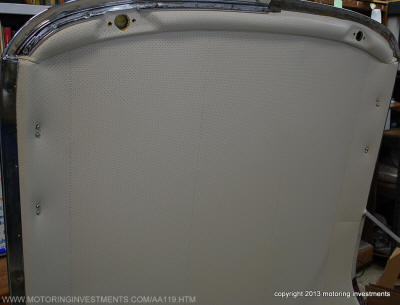 |
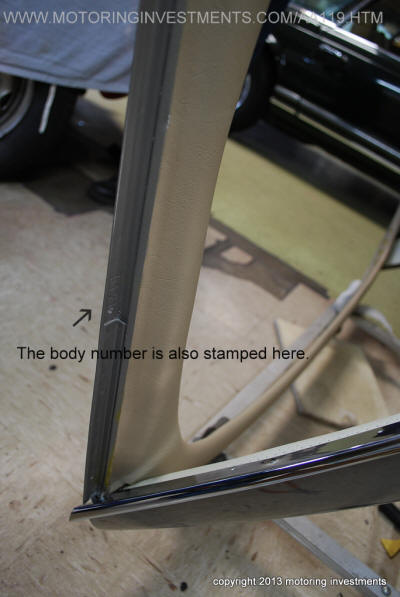 |
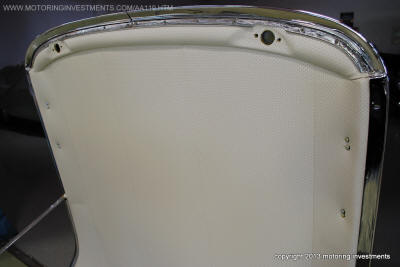 |
| |
|
|
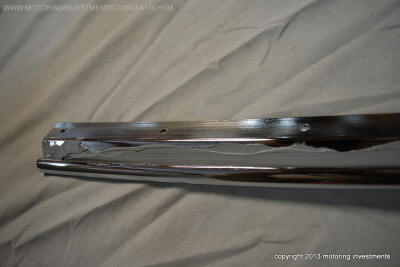 |
The caulking
applied to the chrome
for the hard top needs to be spread evenly
and once installed, remove any excess.
The caulking assures a snug fit and proper
protection against the elements. |
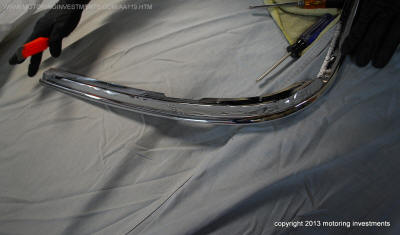 |
| |
|
|
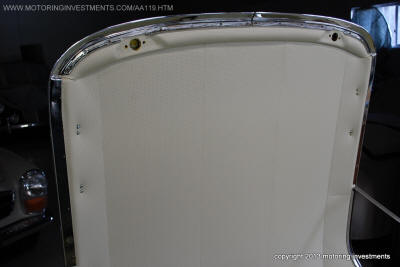 |
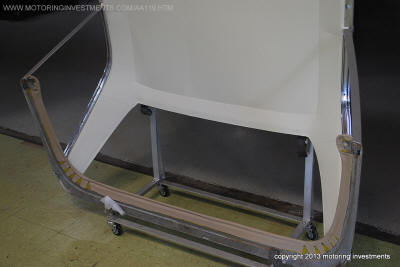 |
 |
| |
|
|
 |
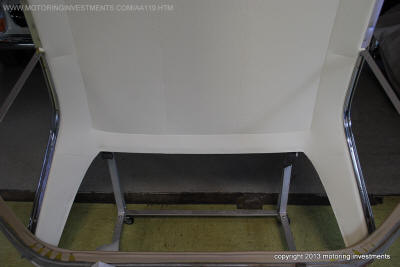 |
 |
| |
|
|
 |
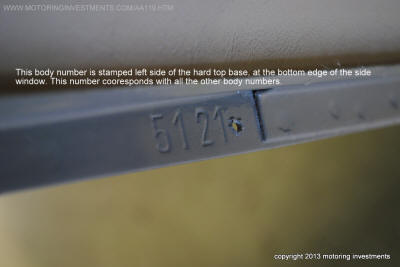 |
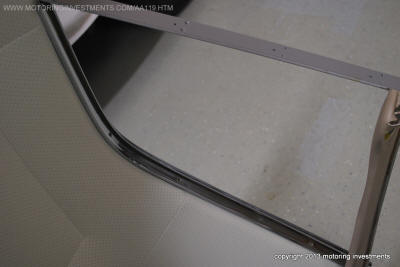 |
| |
The body number
is also stamped on the bottom edge of the
hard top quarter window.
|
|
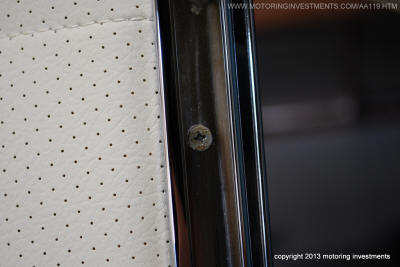 |
 |
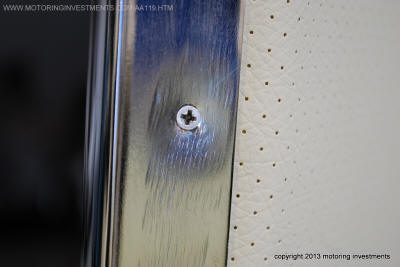 |
| The picture
above show the molding just installed, notice the space? |
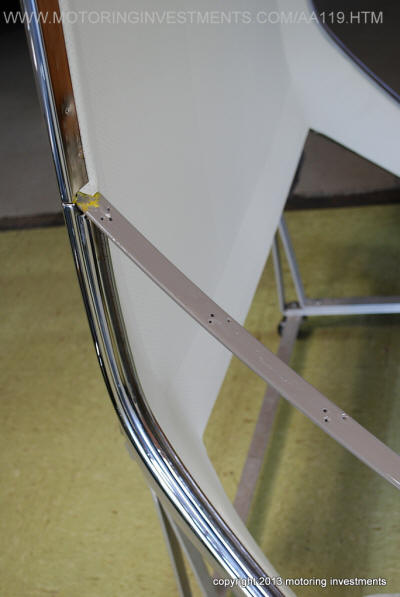 |
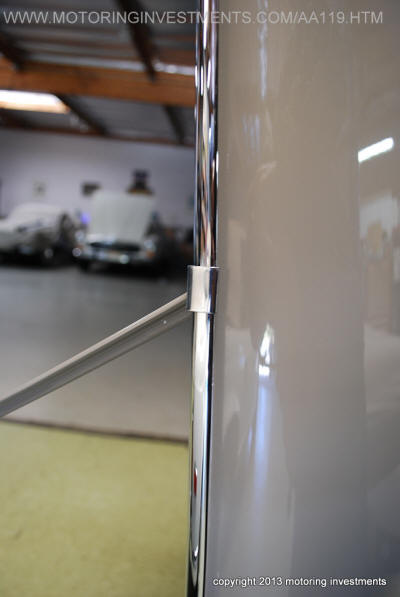 |
| |
The pictures above show the moldings with their
respective joiner clips in place.
These clips finish the trim assembly
process to give the chrome a seamless look.
|
|
 |
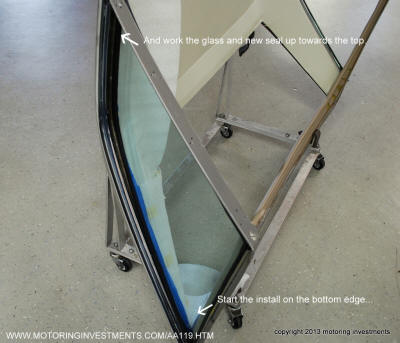 |
|
|
|
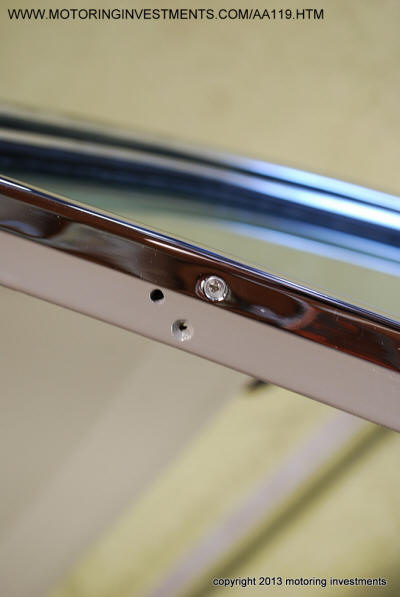 |
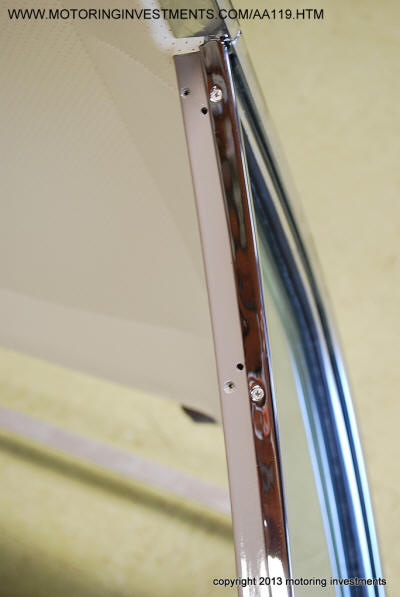 |
|
The photo above shows the precise fit. |
|
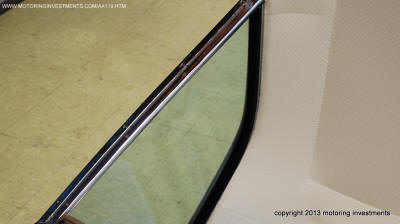 |
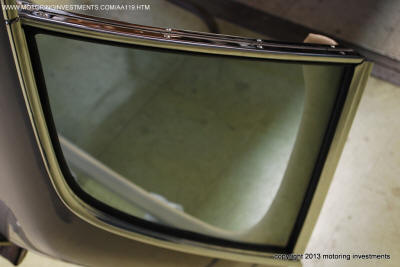 |
The picture above is displaying the chrome
trim installed and fitted with the rubber
profile along the inside of the glass.
This rubber profile helps centralize the
trim installation and seal up from any
outside elements. |
The photo displayed
below highlights the exterior trim
being installed onto the hard top. Notice the
chrome lip that has to sit flush
into position? |
Below is a close up
photo of the correct type of screws
to use while completing
the hard top chrome trim
installation.
Notice the flushness in
relation to the chrome and body?
They must fit perfectly
flush to the body and not stand
proud from the channel
itself. |
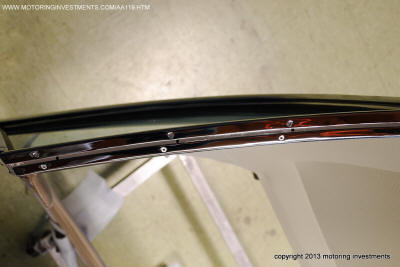 |
 |
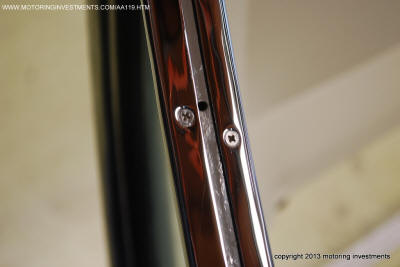 |
The pictures displayed above are of the hardtop quarter glass. These are
especially difficult to install.
Start the install of the glass and new seal at the bottom edge and work
up the glass to the topside.
Notice the protective layer we apply to help guard the
headliner while glass installation is taking place?
The seatbelt pictured below, are restored and ready for installation.
All buckles, decals, chrome, and
labels have been renewed or replaced.
|
|
|
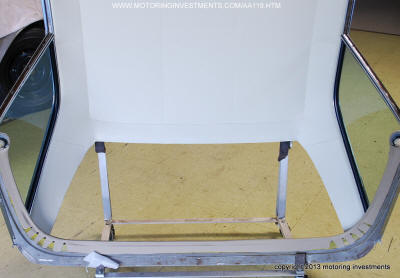 |
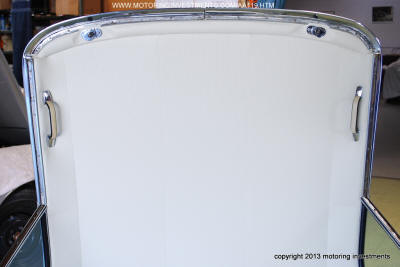 |
|
|
|
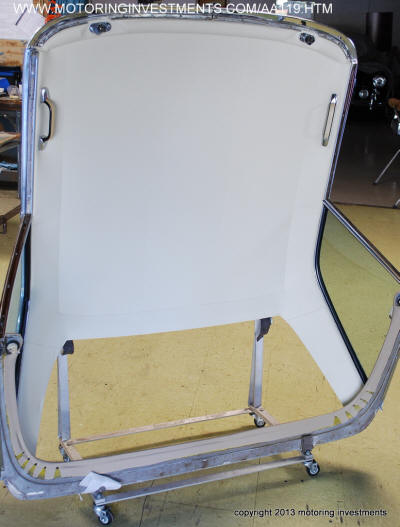 |
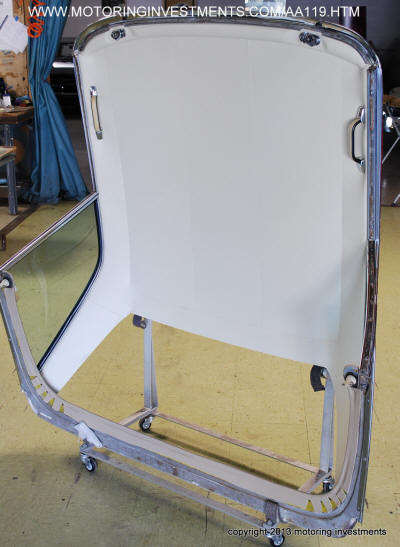 |
|
|
|
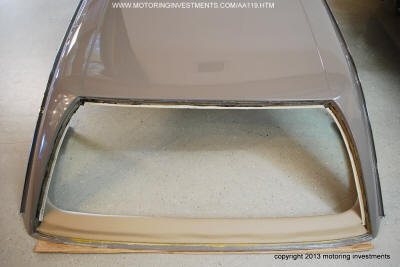 |
 |
|
With no rear glass |
With the glass installed |
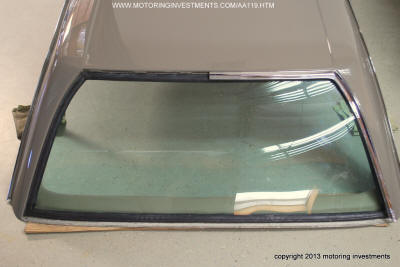 |
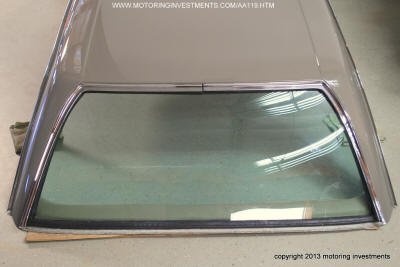 |
|
These pictures above show the rear chrome
trim being installed. |
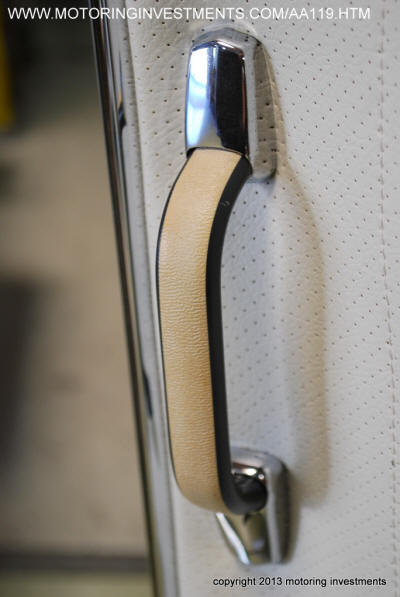 |
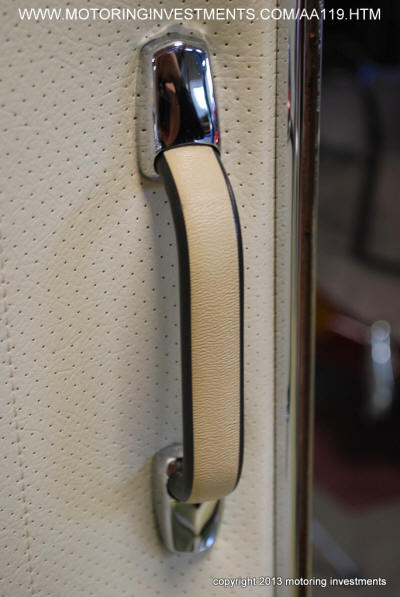 |
|
The hard top handle bases are also re-plated
and feel like new. |
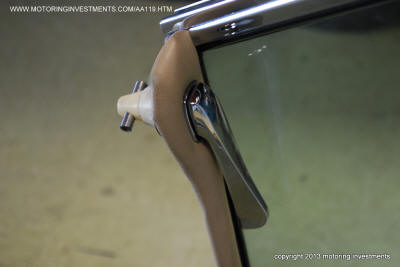 |
 |
The photo above shows the hard top side
latches. These help secure the hard top onto the body. All
new hardware and washers are used to restore the latches. |
 |
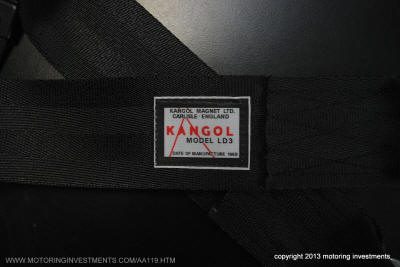 |
|
BEFORE |
AFTER |
 |
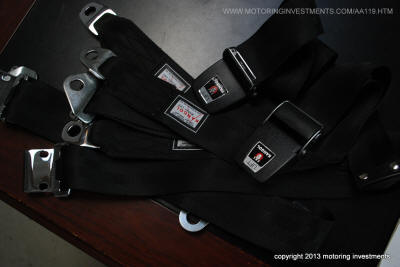 |
The photos below show us the engine bay and its progression.
After testing and tuning, we apply the engine bay decals to finish the
complete restoration.
|
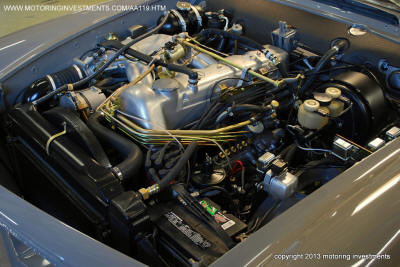 |
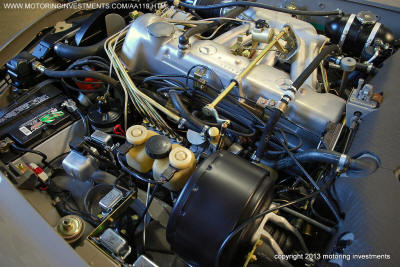 |
The photo below is of the
radiator to fan shroud
clip.
|
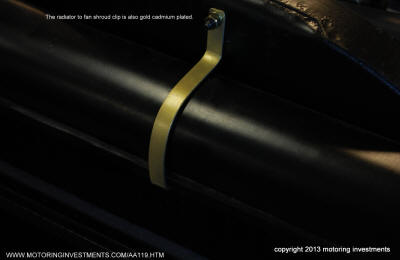 |
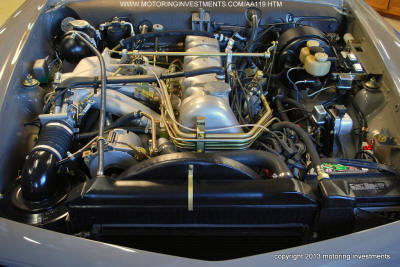 |
The pictures below are of the door mechanisms, fully reconditioned.
All window guides, glass blocks, regulator rods and rubber buffers
are inspected and serviced to function like new. When are doors are
completed, they
will sound and close just like when they left the factory, over 40 years
ago.
|
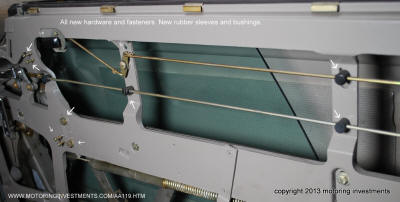 |
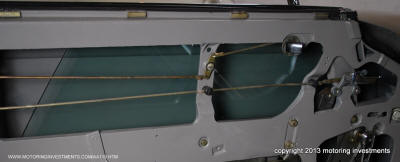 |
| |
|
|
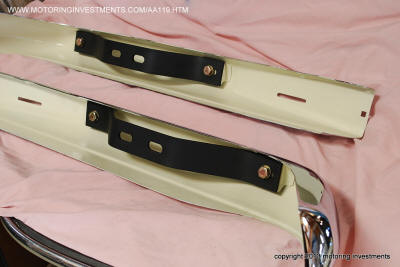 |
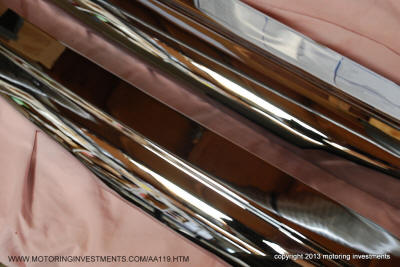 |
 |
The bumper backsides, shown
above and below. Notice the
gold cadmium plated bolts, bumpers brackets,
(refinished to match the correct black)
as well as the light color
used to refinish the backsides?
|
The photo above and below show the
bumpers' seamless look.
Notice they are not drilled with holes for the
cumbersome over riders.
|
The bumper
backsides are
painted to prevent corrosion and
display a finished, correct look. |
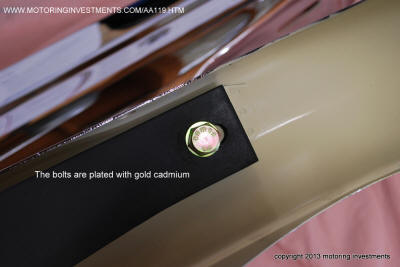 |
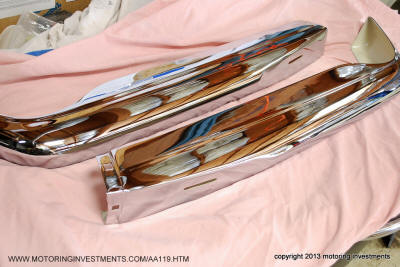 |
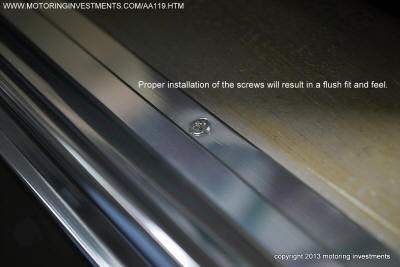 |
| |
|
|
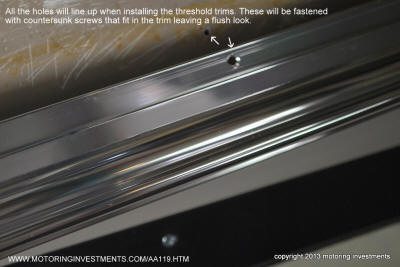 |
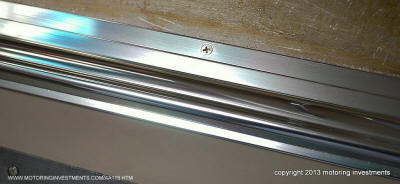 |
The photos
above display the inner threshold trims and their respective matching
points. Notice the
screws and how flush they sit in the trim?
Proper alignment and installation of all the trim and rocker panel cover
screws will result
in a flush fit, thus having no imperfections when installing sill pads
and carpets.
|
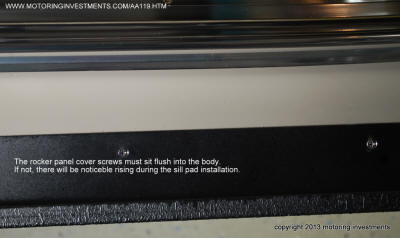 |
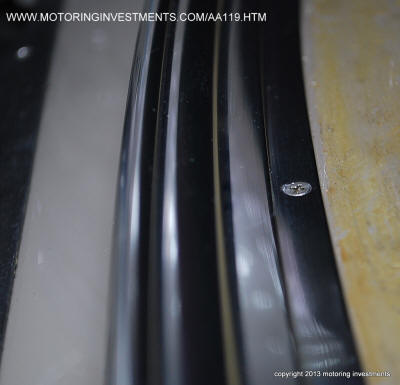 |
| |
|
|
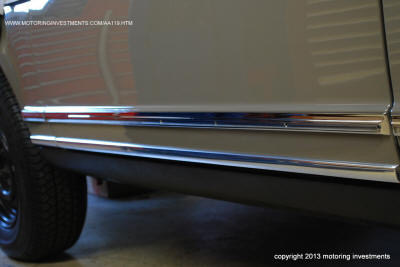 |
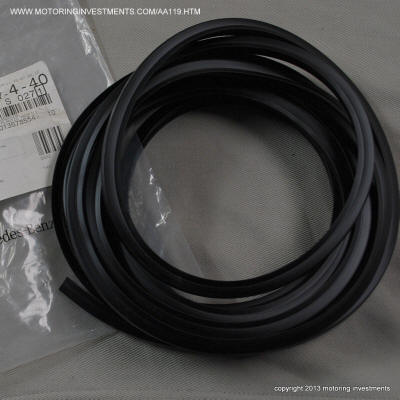 |
 |
| |
The photo above shows the rubber
profile that goes into the chrome door trim. This
profile must be inserted and angle cut to fit correctly.
|
|
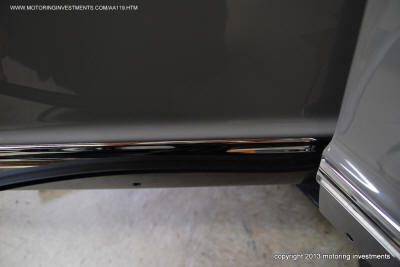 |
Notice the
pictures to the left and right are
of the profile being installed.
The photos below are of the
rubber profile in place and trimmed to fit. |
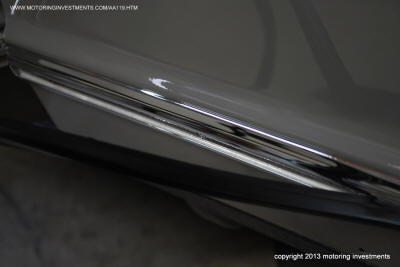 |
| |
|
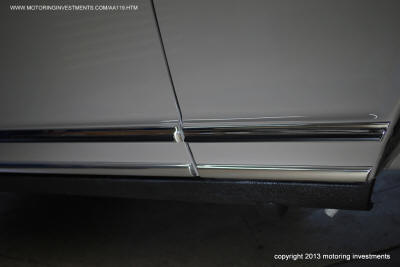 |
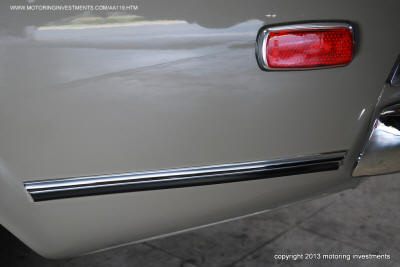 |
| |
|
|
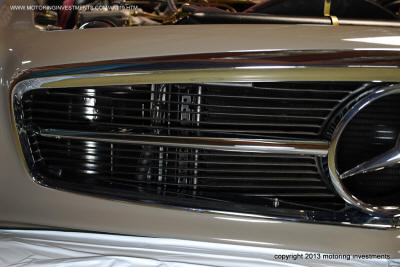 |
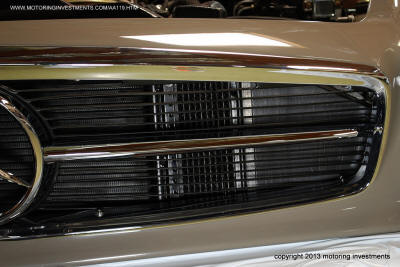 |
| |
Flawless
chrome grill. |
|
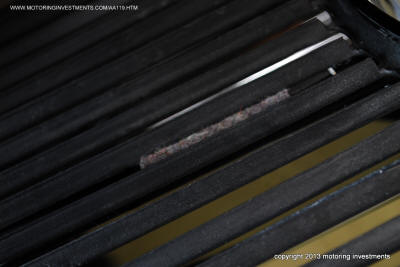 |
The photos to
the left and right
are of the
small
felt pieces that go affixed onto the
backside of the chrome grill center bars.
Often missing on even most high point
restorations, we produce
every detail, no matter how small
or inconspicuous. |
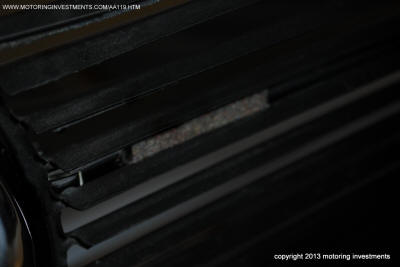 |
| |
|
|
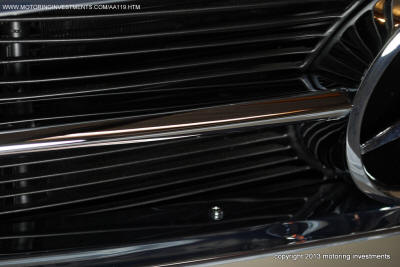 |
 |
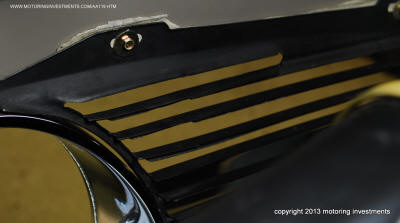 |
| The front grill center
bar. |
The photos
above and below
highlight the perfect fit from nose to
grill. |
The protective tape that
is
applied to the bug grill
is visible from the backside, as per
factory original. |
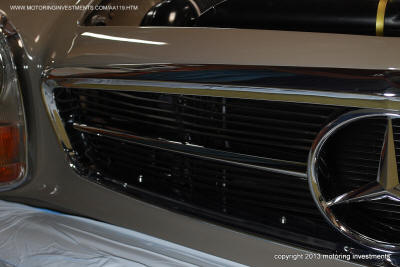 |
 |
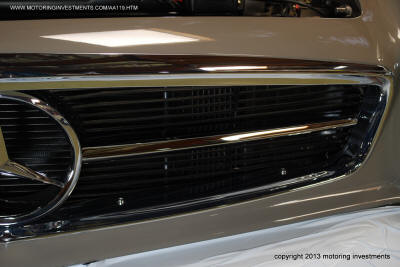 |
| |
The photos
shown here, highlight the
impeccable finish of the newly
plated chrome, and its fit with the body.
|
|
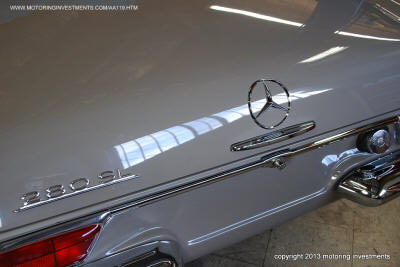 |
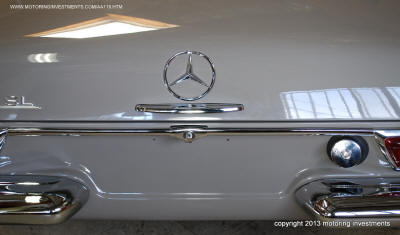 |
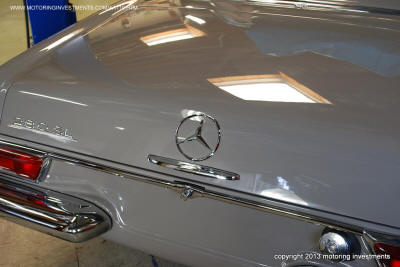 |
| |
|
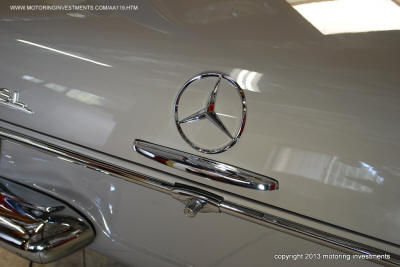 |
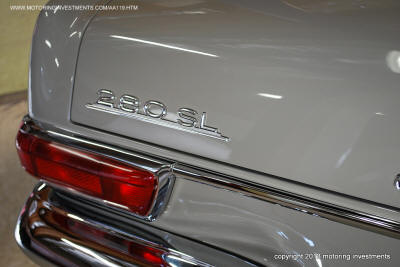 |
| |
|
|
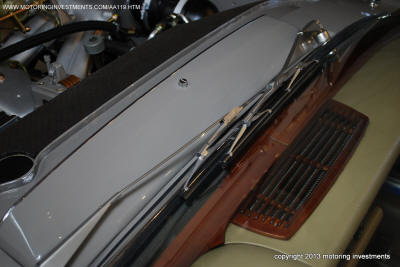 |
 |
The photo
above shows the correct
windshield wiper units. |
The correct screws that mates the fresh air
scoop to the body is also
gold cadmium plated.
Many times, these screws are incorrectly
painted over or not re-plated with
gold cadmium as per factory.
These screws should be easy to
remove, for a technician to be able to service the hoses
or mechanisms under the scoop.
|
 |
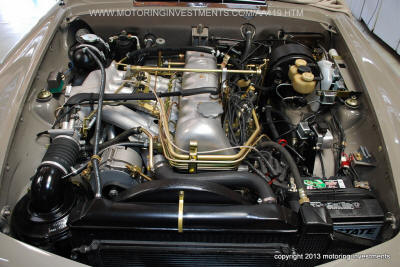 |
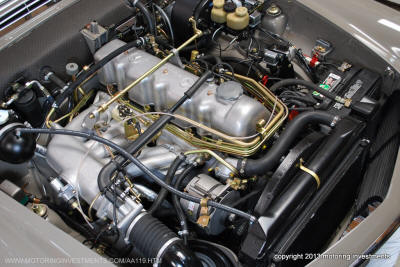 |
| |
|
|
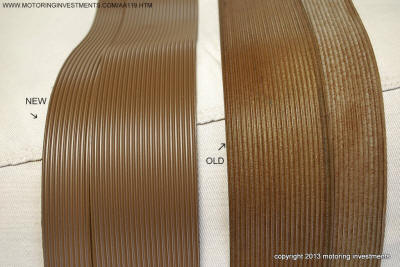 |
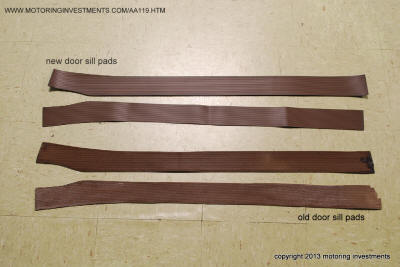 |
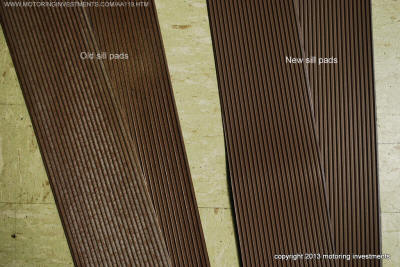 |
The photos
above are of the door threshold sill pads.
These are no longer available new in the original
colors.
As supplied by Mercedes they now only come in black.
We have refinished New OEM
door sill pads to match the correct and
original color code that this 280SL was born with.
Look closely at the new vs. old sill pads pictures above, the color is a
perfect match.
Pictured below are different angles of the door sill pads installed onto
the car.
|
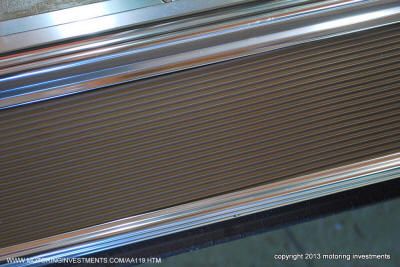 |
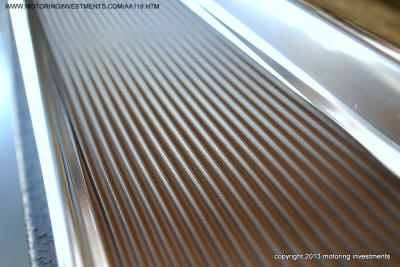 |
| |
|
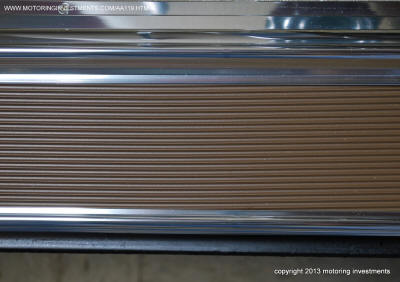 |
 |
| |
|
|
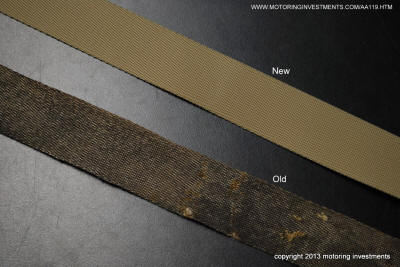 |
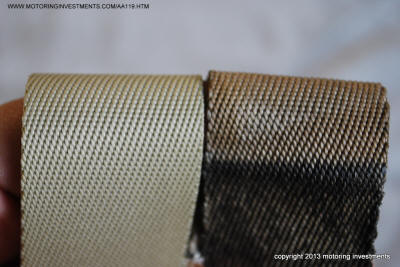 |
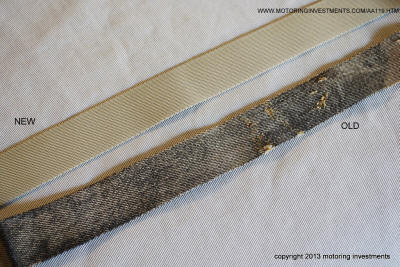 |
The photos above are of the New Old Stock (N.O.S.) hood limiting strap.
The straps are labeled in the pictures and it is easy to see the
difference that 40+ years make in the engine bay. In the picture
above center,
note that the weave is a perfect match to that of the original item.
This item came from our "secret parts bin". What Mercedes typically supplies
today is a reproduction, that is pure white.
|
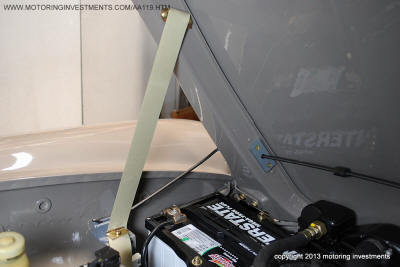 |
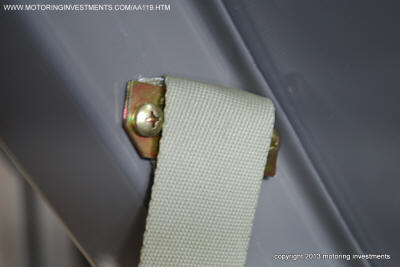 |
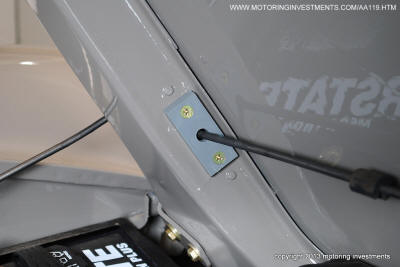 |
The
surrounding pictures
show us the mounting
plates on the hood and the new
hood limiting strap in place. |
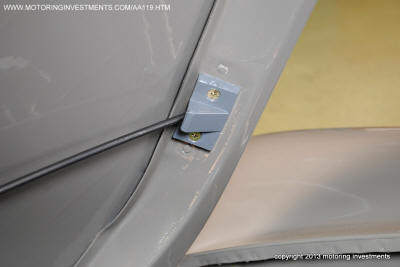 |
| |
|
|
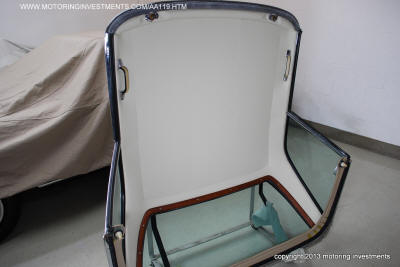 |
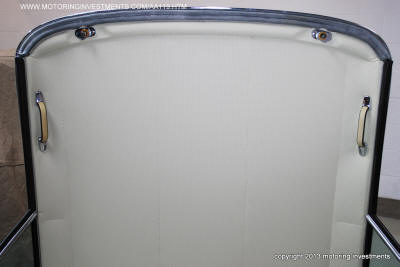 |
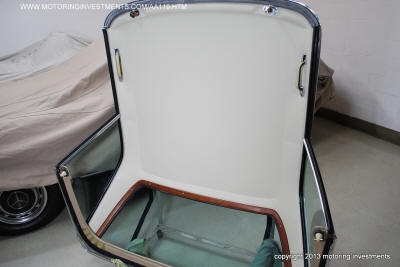 |
The photos above and below show the hard top in the finished state.
With nylon buffers installed to the locking latches and new screws and
cup washers on the
rear wood trim, the hard top is ready to go on the car. |
 |
 |
| |
|
|
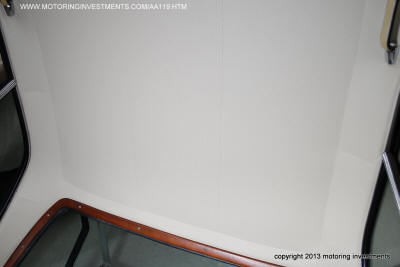 |
 |
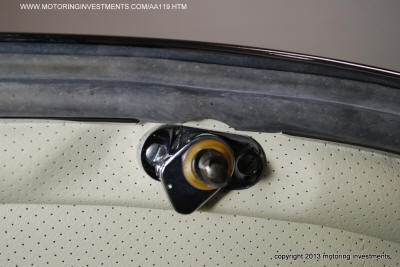 |
| |
|
|
 |
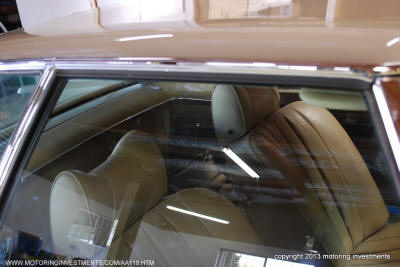 |
 |
| |
The images
above are of the glass
being adjusted to fit the
hard top. Then the soft top
frame is adjusted to the respective
glass position. |
|
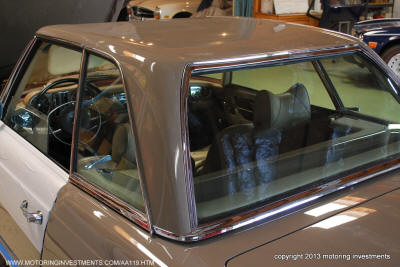 |
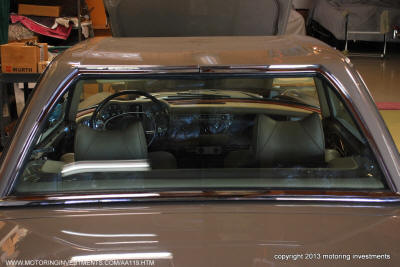 |
 |
| |
The photos
above and
below show the chrome trim and corners. |
|
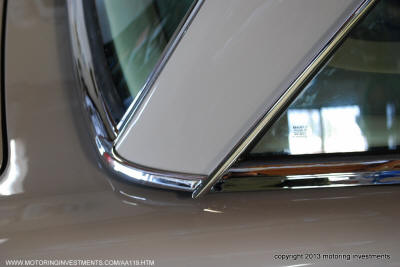 |
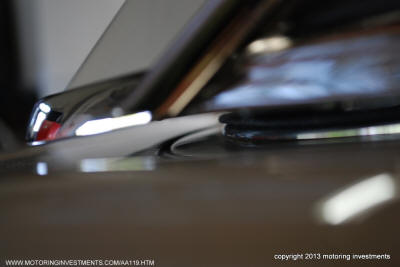 |
 |
| |
The hard top rests on the body with ease
and the picture above highlights the
clearance between the hard top and the body.
|
|
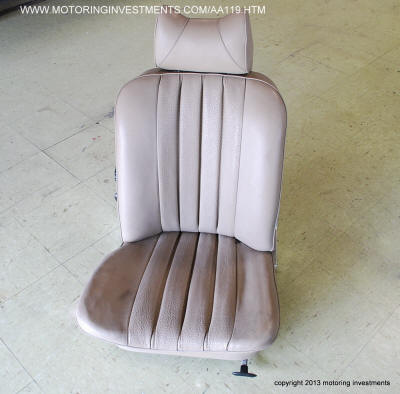 |
Here are
pictures of the seats before we disassemble
and rebuild them.
And the newly
restored seats are pictured below. |
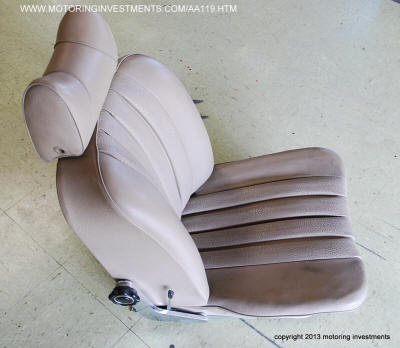 |
| |
|
|
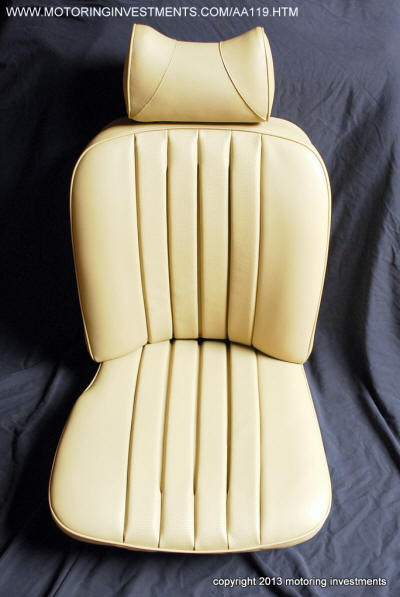 |
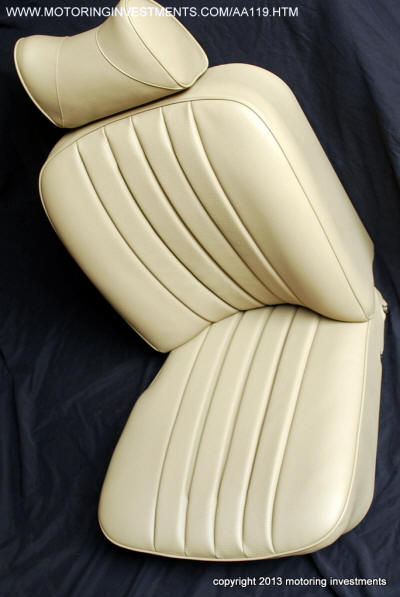 |
The door
panels are shown below, restored and covered with new material (note:
differences in lighting are
responsible for the drastic apparent difference in shade). |
 |
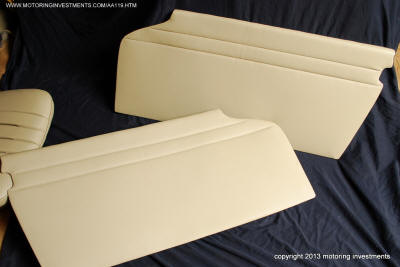 |
The picture
below shows the just one of the many details that go into restoring a
car to this level. We obtained factory
correct and color matching eyelets to fit the seat backs where the head
rest rods pass through (made of "unobtainium"). |
| |
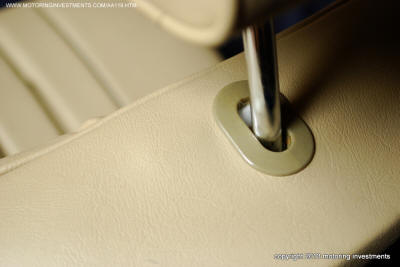 |
|
Below are
some close up pictures of the ashtray lid and its completed look. We
carefully
remove the bezel and have everything re-plated, followed by re-padding
and recovering the center. Assembly is very tricky with
the delicate tabs seen in the middle picture below. |
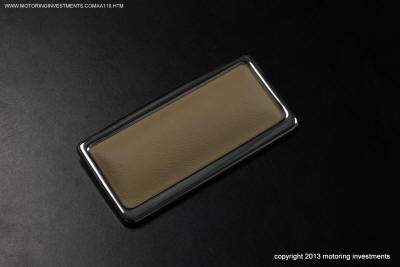 |
 |
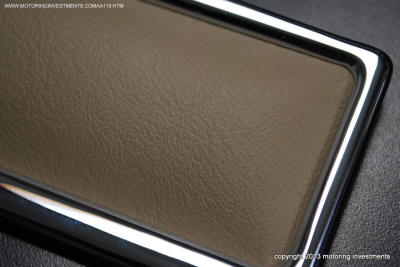 |
| |
|
|
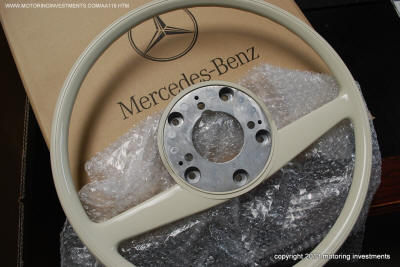 |
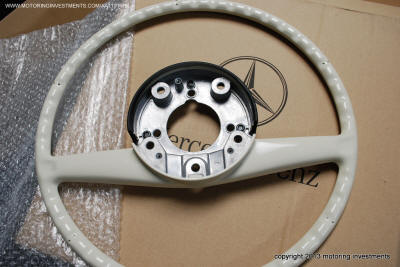 |
The new
Mercedes Benz ivory steering wheel and shifter knob are
ready to accept the horn ring and pad installation. |
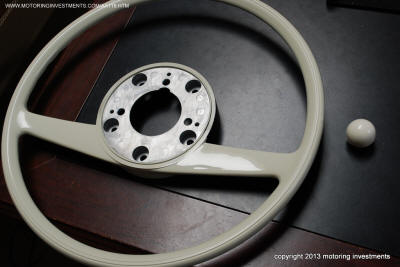 |
 |
| |
|
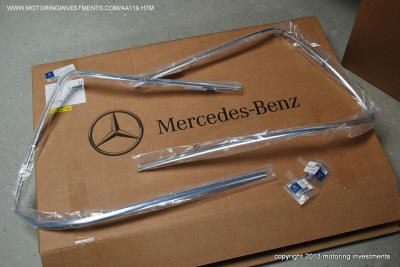 |
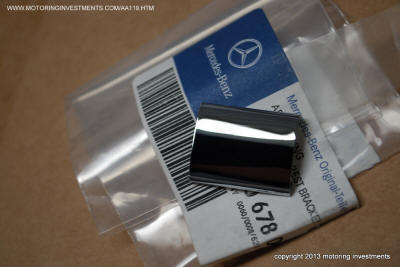 |
| |
|
| Regarding tool bags,
the factory workman grabbed whatever bag happened to be on his tool bag
cart for the next car that came down the line. Sometimes a tool bag
happens to match a particular car's interior upholstery but this is
merely by chance. Most original 280SLs that I have experienced have had
a tool bag that differs from the upholstery color and material. The bags
were either M-B Tex or convertible top canvas.
In this case our client has opted for a bag that
matches his beige upholstery so we made one. |
 |
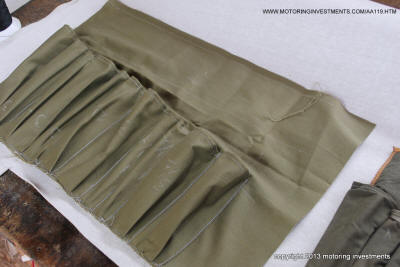 |
| An original
tool bag shown above, was used this as a template. |
The finished
liner sitting atop the back of the beige M-B tex |
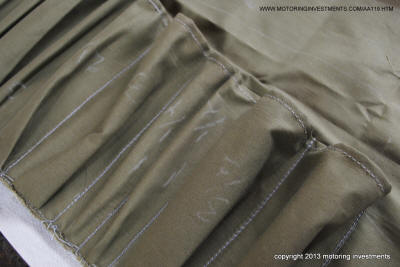 |
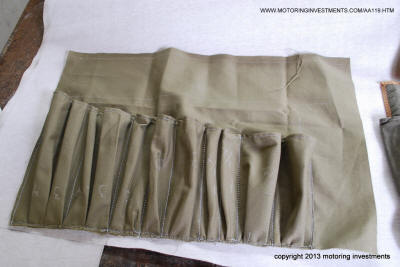 |
Every detail is duplicated right down to the snaps.
|
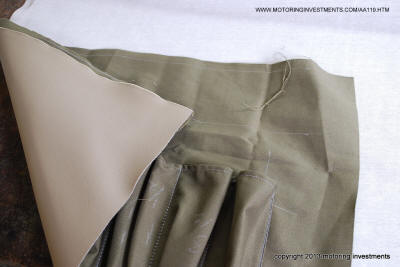 |
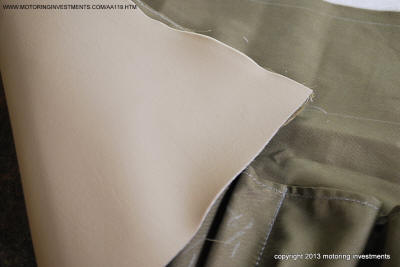 |
| |
after_small.JPG) |
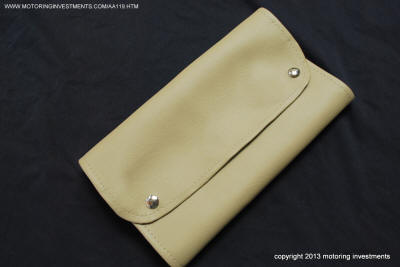 |
The picture
above shows the
before and after tool bags. |
The tool bag
is completed with new
tools and fuse box below. |
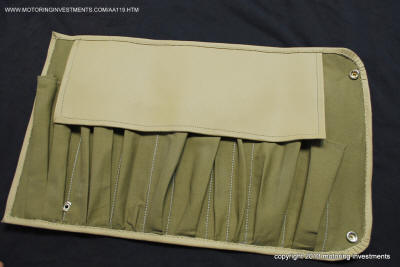 |
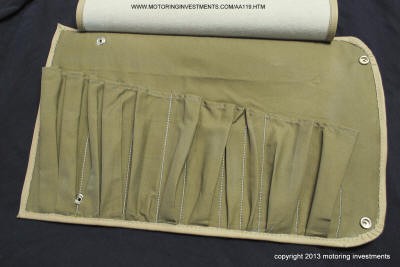 |
| |
|
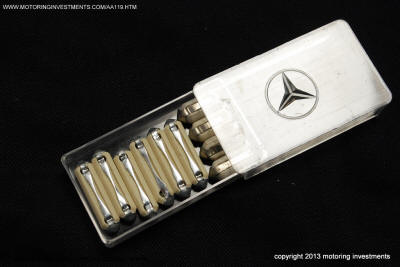 |
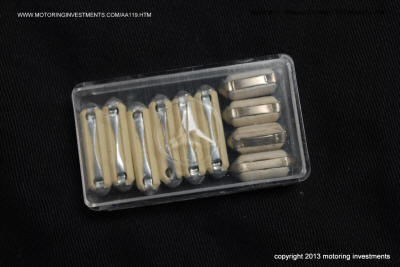 |
| The picture
above shows the correct number of fuses in the spare fuses box. |
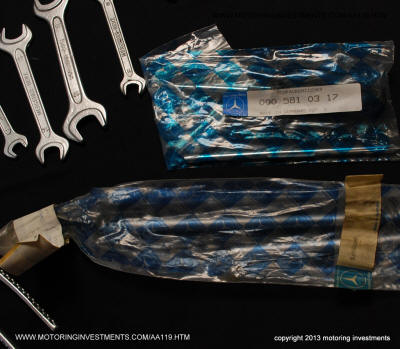 |
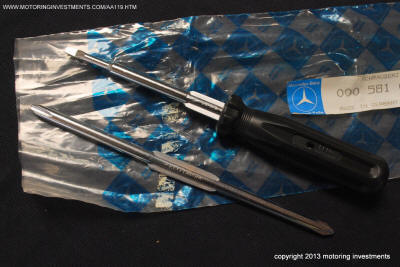 |
| |
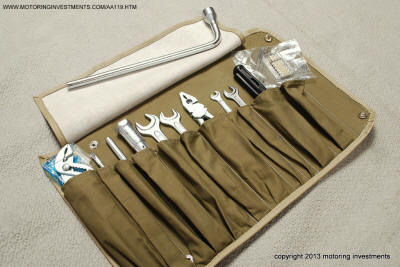 |
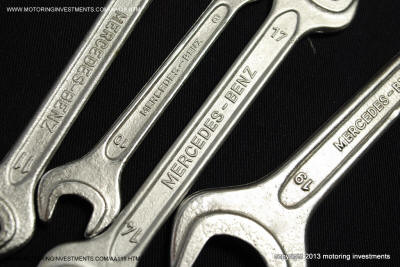 |
|
|
|
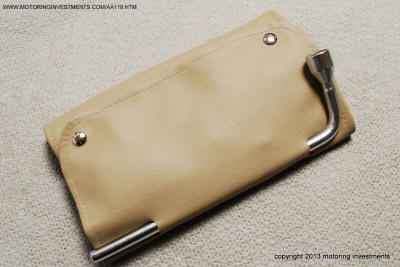 |
 |
The photos
below on this column
represent the BEFORE condition of the trunk interior panels.
Made of a simple cardboard type material,
these panels often break or
become missing. |
Below here we
have pictures of
the newly acquired trunk panels for the
left and right sides. |
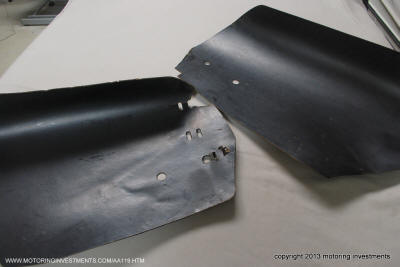 |
 |
| |
|
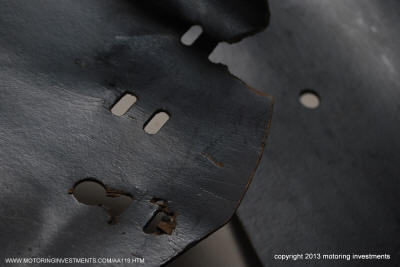 |
 |
Pictured
above are shots of the
panels before we replaced them.
The foam has disintegrated from over 40 years. |
Below is a
picture of the
NEW trunk panel and its backside shows
the foam padding. |
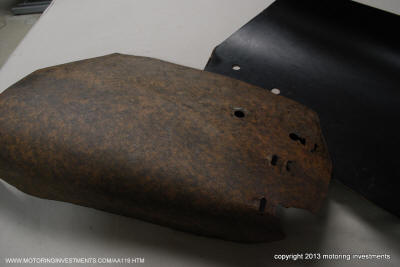 |
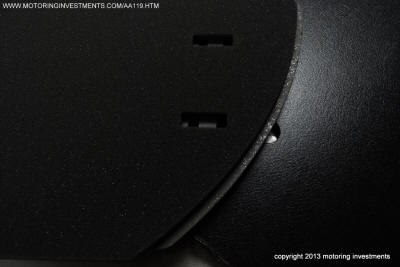 |
| |
|
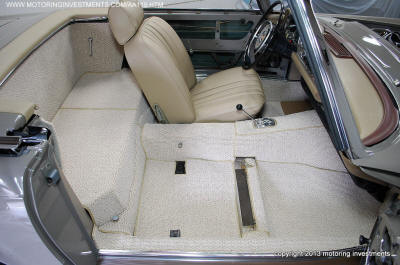 |
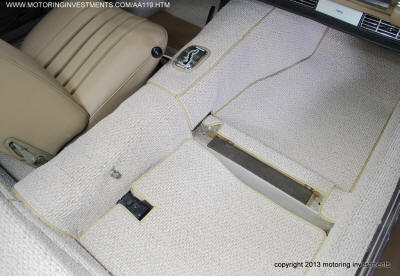 |
| |
|
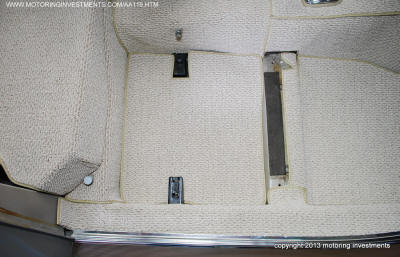 |
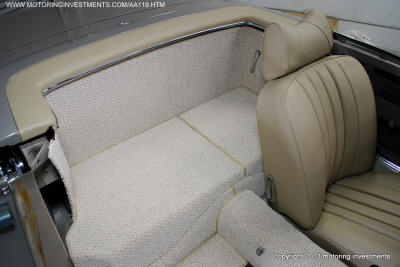 |
| |
|
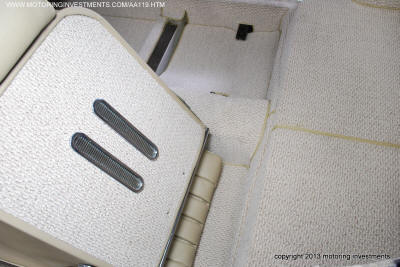 |
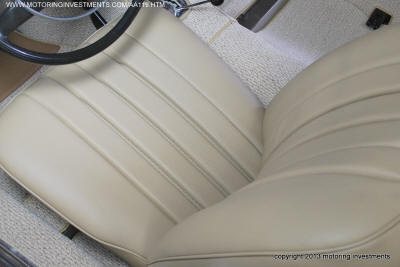 |
| |
|
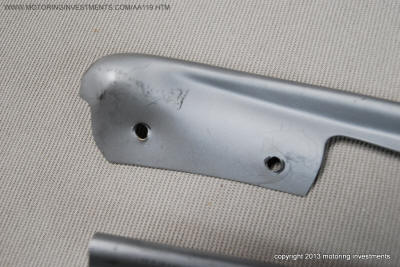 |
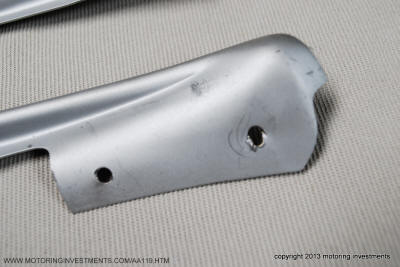 |
The
trims at the windshield header bar are shown here.
These will be re-plated to look like new. |
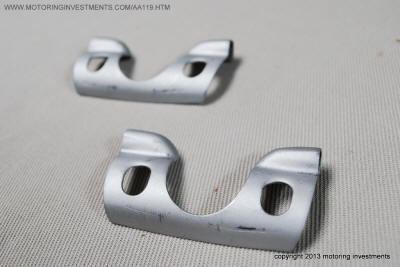 |
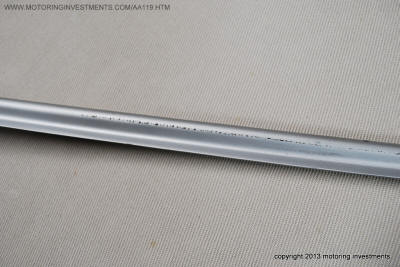 |
In the images shown below, we have stripped all the previous plating and
revealed the brass metal underneath. We then polish the surface to a
smooth finish.
Followed by the re-plating with nickel to achieve the
factory correct look.
These trims, along with the horn ring, were finished in a dull
nickel/matte coating.
These parts were as such on US version cars, due to the strict D.O.T (
Department of Transportation) regulations
enacted. Mandating a non-reflective coating on parts that could
hinder/obstruct a drivers view.
|
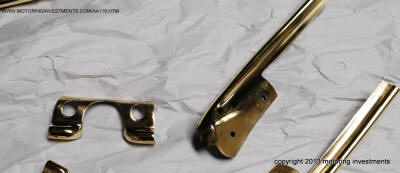 |
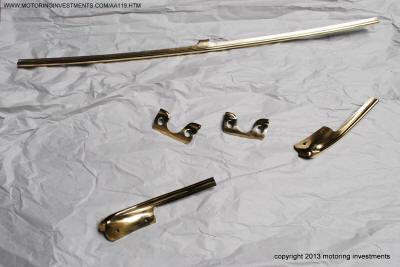 |
| |
|
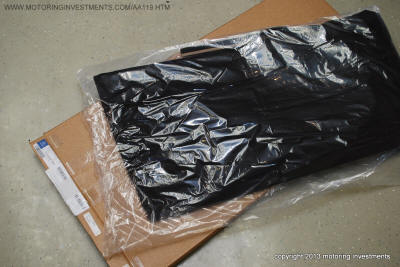 |
 |
The correct
OEM folding
canvas top arrives from Mercedes Benz.
The Vehicle Data Card ( build sheet) reads as this car having a dark
brown canvas top. |
 |
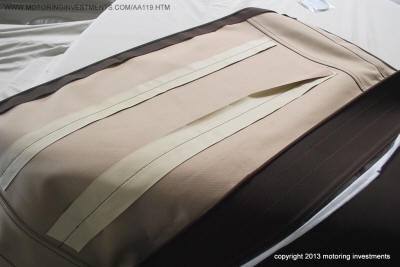 |
After we inspect the new canvas top for any imperfections,
We will begin installation of the new material to the folding top frame.
Mercedes Benz ships their folding canvas tops with the rear window piece
still hanging in place protected with tissue paper.
This helps to protect the rear window from shipping scuffs, creasing and
bending.
After installation is competed, the small threads will be cut out and
will reveal a scratch free, flawless
rear window.
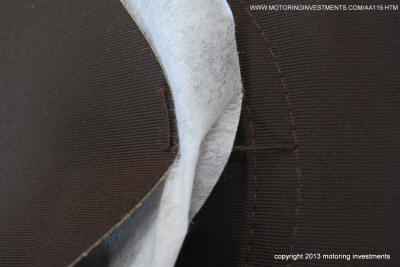
|
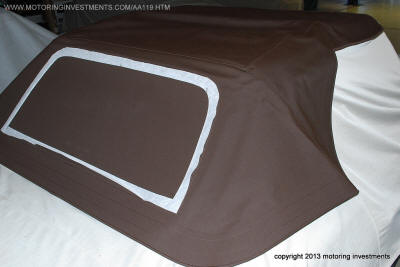 |
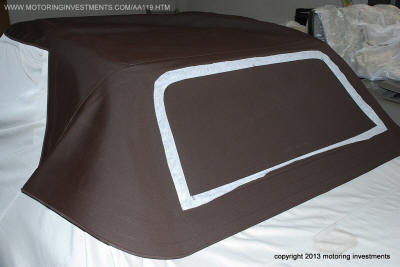 |
We start by stripping the folding top frame of all materials.
After all folding top securing bolts are inspected and adjusted, we
remove strapping from bows. We clean the entire folding top frame from
old glue and any fabrics.
This assures a proper adherence for the new glue and new canvas
material.
|
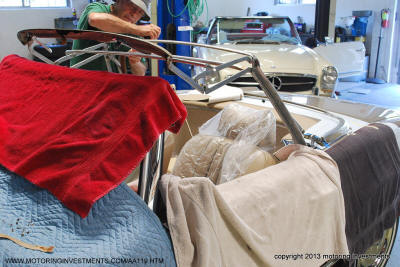 |
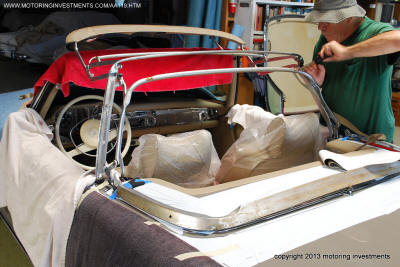 |
| The header
bar is also rewrapped with new vinyl. |
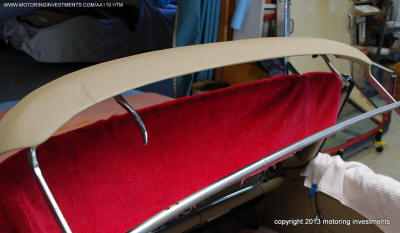 |
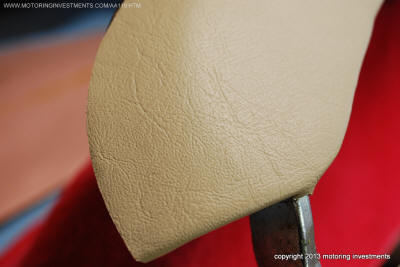 |
| |
|
 |
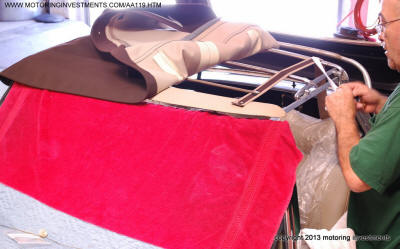 |
| Our expert
upholstery technician installing the OEM canvas top. |
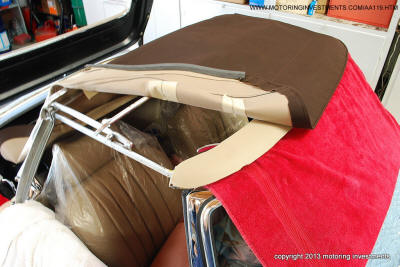 |
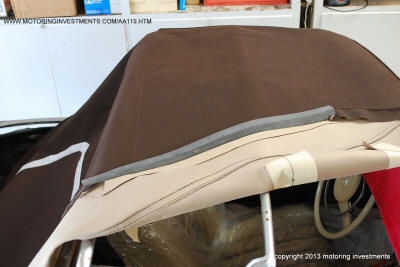 |
| |
|
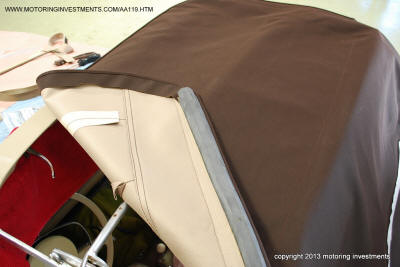 |
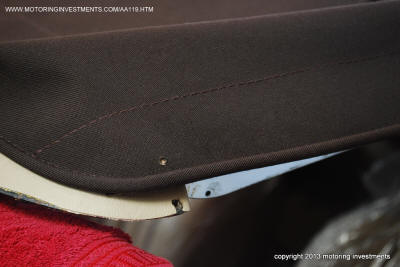 |
| |
|
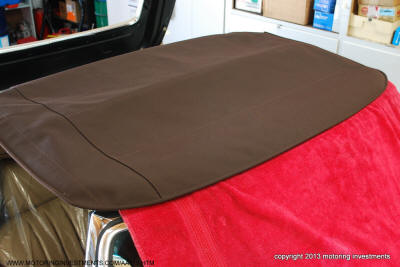 |
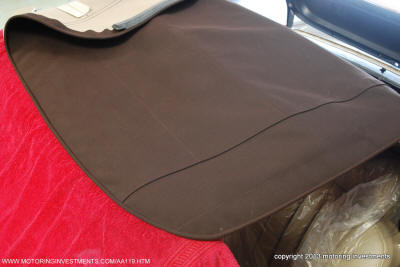 |
| |
|
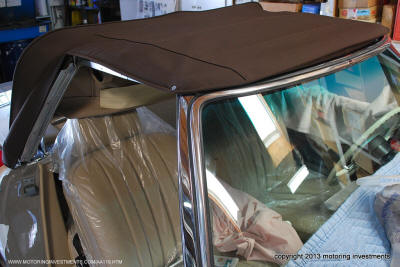 |
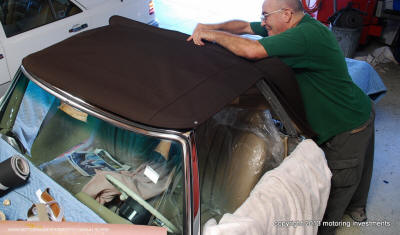 |
| |
|
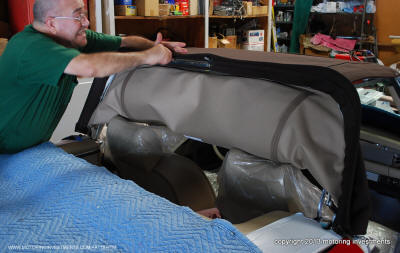 |
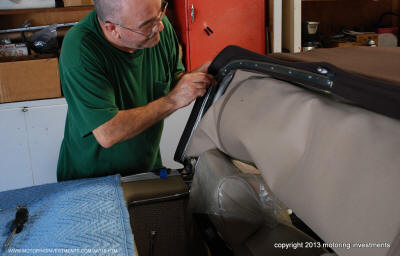 |
| |
|
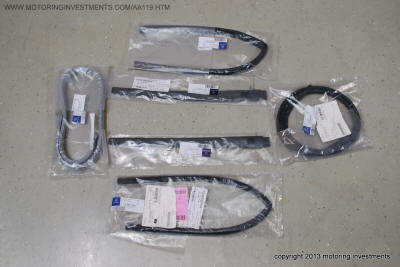 |
 |
The weather seals for the folding top
installation are all pictured above.
We find that using the correct OEM (Original
Equipment Manufacturer) weather seals
provides for the best results. Non-OEM ( aftermarket) weather seals on the market today
do not fit correctly and are NOT molded to fit like the correct OEM
seals.
|
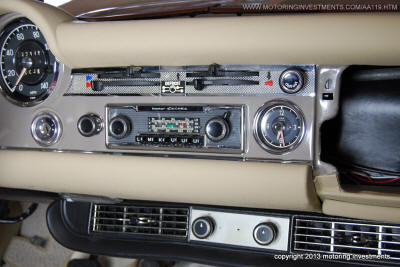 |
 |
| The images of
the glove box area and remaining crash pads are shown above. |
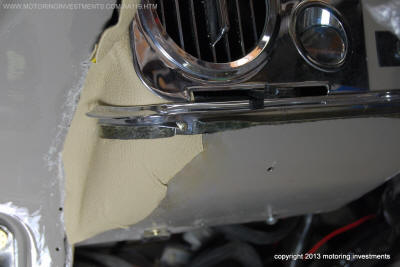 |
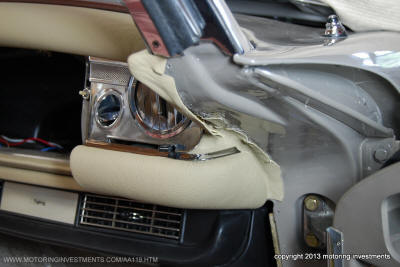 |
The images shown above are of the wrapping under the fresh air vents.
The image on the left shows the wrapping and picture to the right, is
with the crash pad/knee bolster
in place.
|
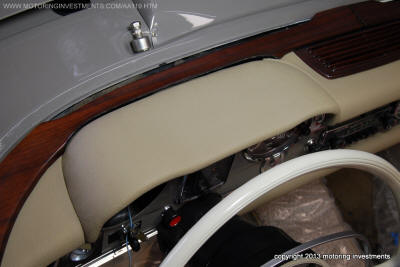 |
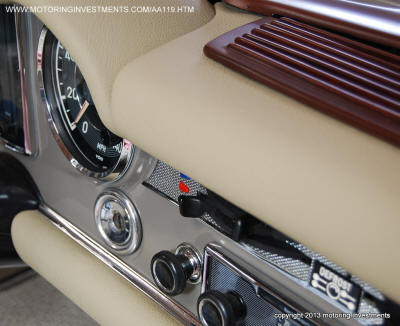 |
| The images
above and below are highlighting the finished dash panels. |
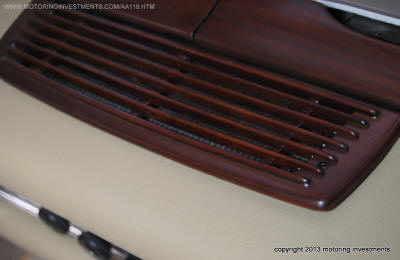 |
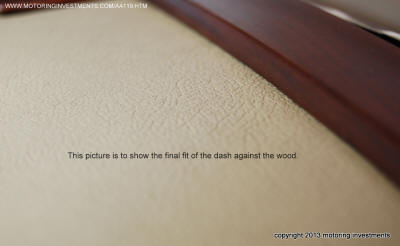 |
| The pictures
above show the final fit of the wood to the dash, absolute perfection. |
 |
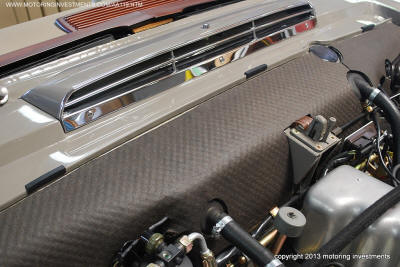 |
| The photos
above and below highlight the engine bay in its current state. |
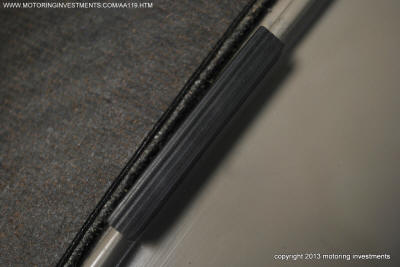 |
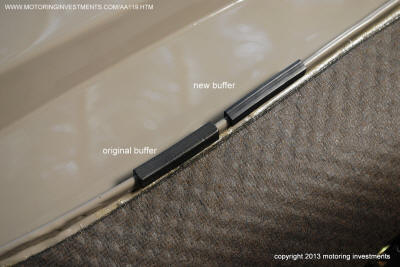 |
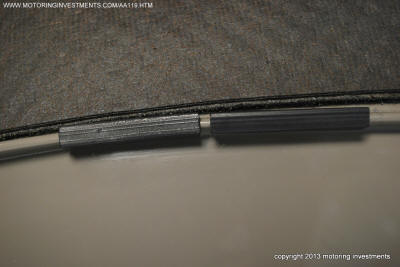 |
The firewall
lip to engine hood buffers are pictured above. Notice the lines on the
topside of the original buffers?
We have exact duplicates to replace the original buffers that are over
40 years old. |
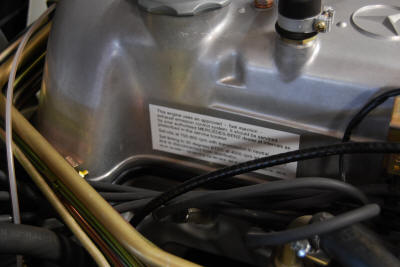 |
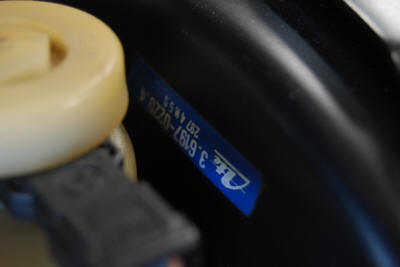 |
| Valve Cover
decal |
Brake Booster
decal |
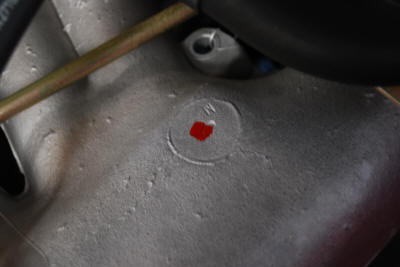 |
 |
A dot of red paint
atop of the intake manifold.
This dot symbolizes our foreman has inspected, tuned and
all mechanical systems met factory standards.
Just like the lead technician
would have done over 40 years ago.
|
Correct decal
placed
atop the transmission dipstick. |
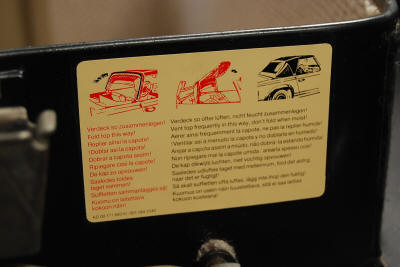 |
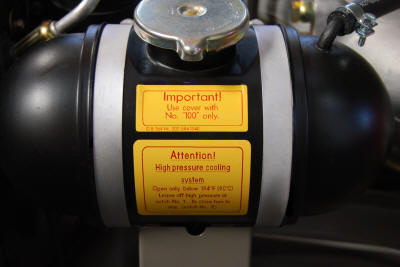 |
| The folding
top compartment instructions decal. |
The decals
are placed on water catch tank. |
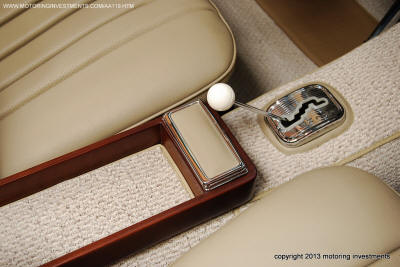 |
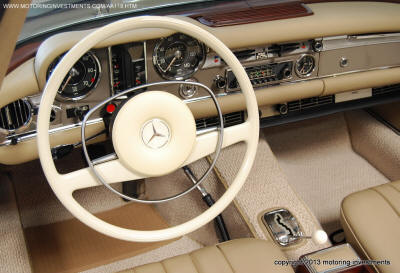 |
| |
|
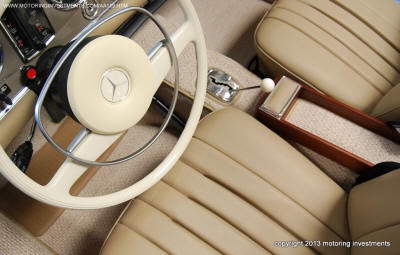 |
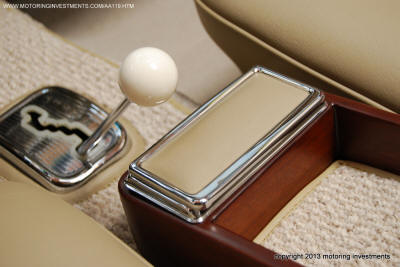 |
| |
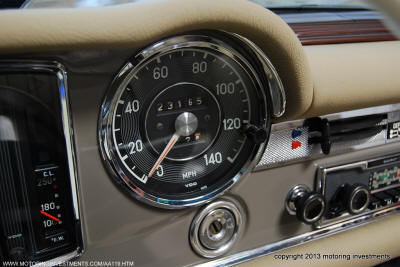 |
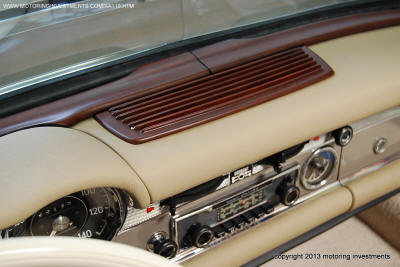 |
| |
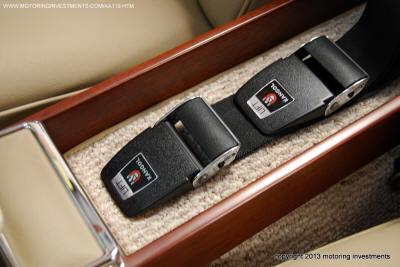 |
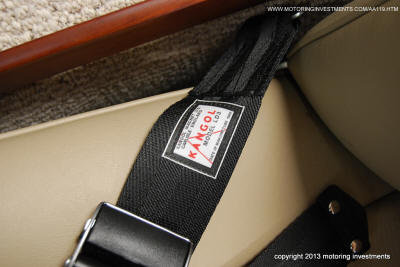 |
Notice the
restored seat belts and the date codes? Labeled
"date of manufacture 1968". We elevate
these cars to a level that the original factory technicians would be
proud of.
From correct dotology through out the car to date codes on seat belts,
every detail is duplicated and documented. |
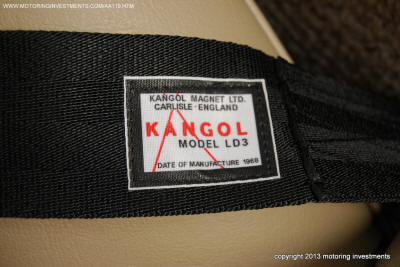 |
 |
| |
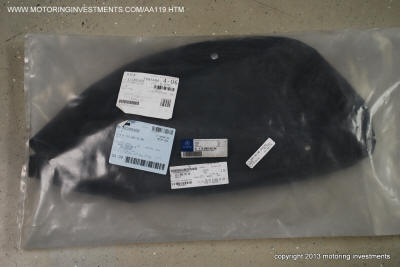 |
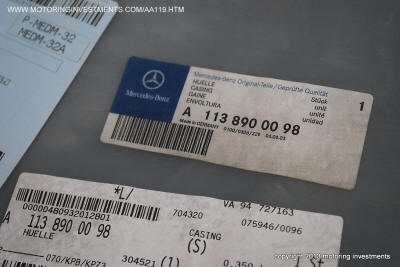 |
| The spare
tire casing or "cover" as it arrives from Germany. |
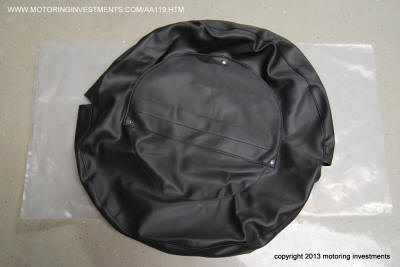 |
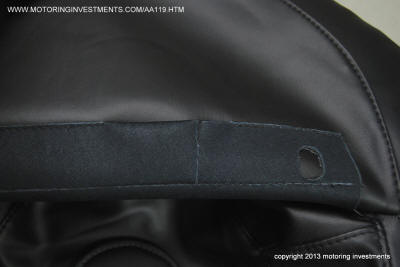 |
The
special compartment for the tire iron and wheel
installation alignment tool is shown above. |
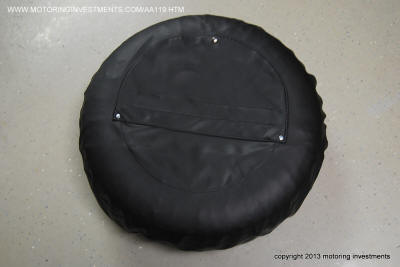 |
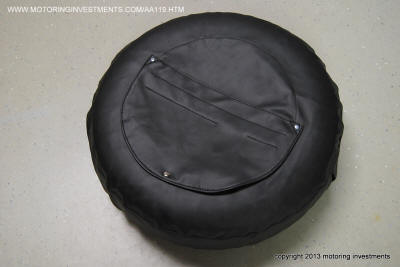 |
The keys pictured below were ordered from the factory in Germany.
These keys were cut to V.D.C (Vehicle Data Card) specifications
and basically proves that the car has not
been subject to a door handle replacement, lost keys or a re-keyed
cylinder.
This is an original 3-key car,
meaning one key for ignition,
another key worked the doors and gas cap,
and lastly the glove box/trunk lock key. |
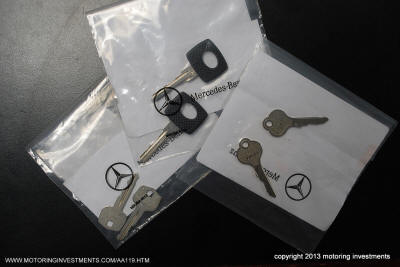 |
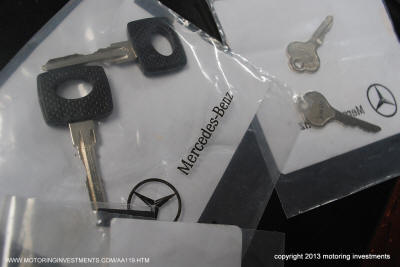 |
| |
|
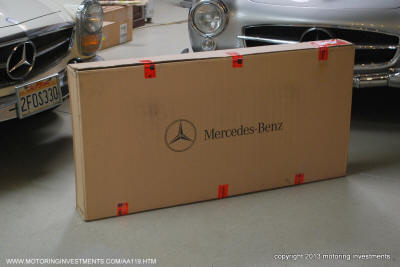 |
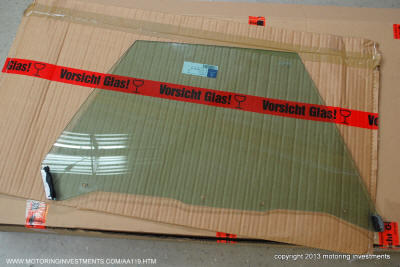 |
| New side
glass arrives from the factory. |
 |
|
| |
|
| |
|
| |
|
| |
|
| |
|
| |
|
| |
|
| |
|
| |
|
| |
|
| |
|
| |
|
| |
|
| |
|
| |
|
| |
|
| |
|
| |
|
| |
|
| |
|
| |
|
| |
|
| |
|
| |
|
| |
|
| |
|
| |
|
| |
|
| |
|
| |
|
| |
|
| |
|
| |
|
| |
|
| |
|
| |
|
| |
|
| |
|
| |
|
| |
|
| |
|
| |
|
| |
|
| |
|
| |
|
| |
|
| |
|
| |
|
| |
|
| |
|
| |
|
| |
|
| |
|
| |
|
| |
|
| |
|
| |
|